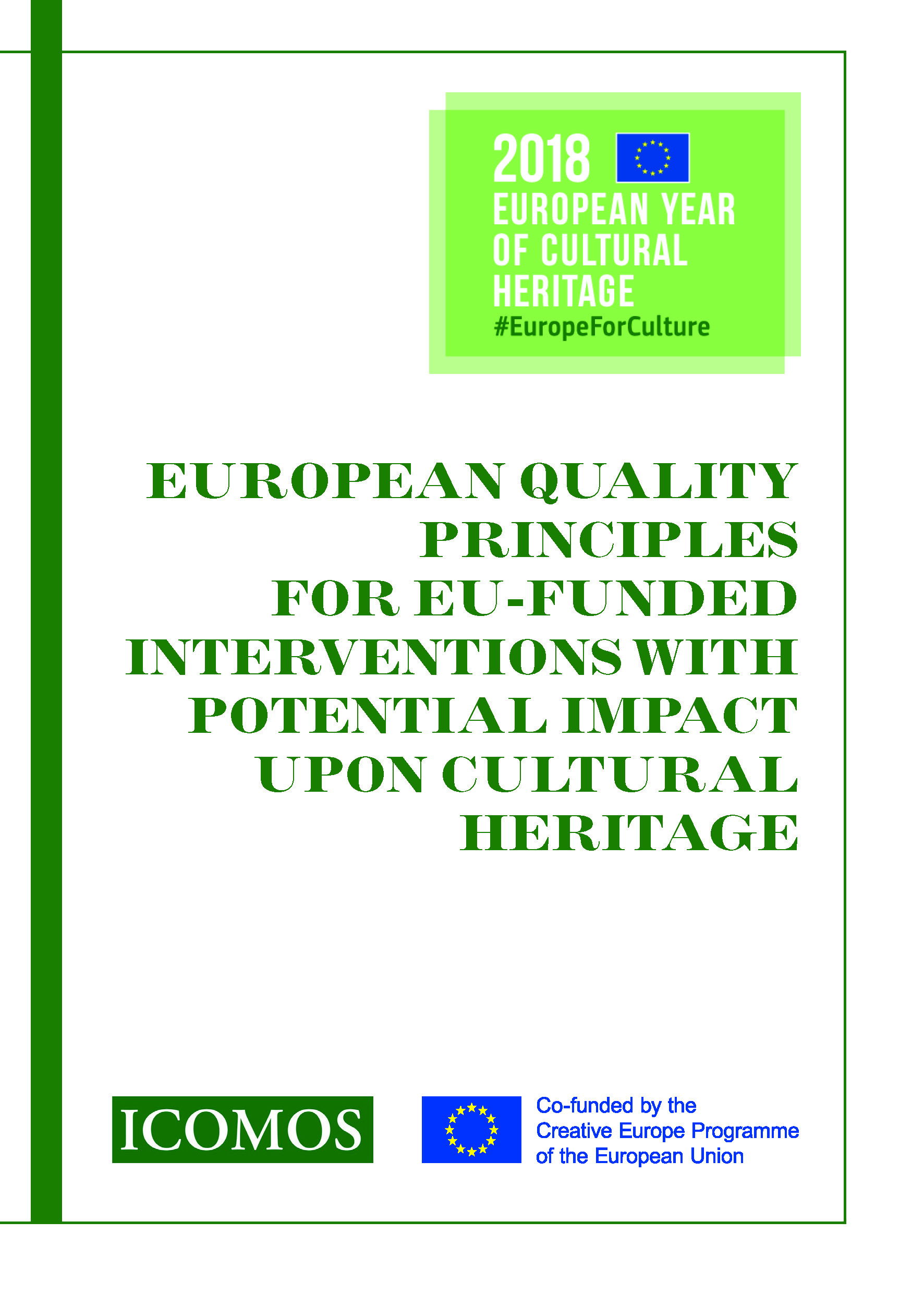Received in 2023 at the ICOMOS Documentation Centre
ICOMOS
Volume XXI of the series Monuments and Sites published by ICOMOS is the second of the series (after volume XIX) to document the work on the Buddha figures and on the World Heritage Site in the Bamiyan Valley. The first chapter presents the latest research on the polychromy of the Buddha figures, while the second chapter documents the work of the ICOMOS working groups on site from 2010 to 2014. Chapter three provides among other things information on demining and includes a comprehensive contribution by the Department of Historical Monuments, Ministry of Information and Culture of Afghanistan. Constance Wyndham describes the opinions of the inhabitants of the Bamiyan Valley on the current situation. Chapter four contains historical reports on the Buddha figures and on the Bamiyan Valley and UNESCO reports, as well as the unpublished dissertation by Abdullah Amiryan, Renata Piarelli and Gabriele Bruckmann (1975/76), as well as remarkable photographic images by Dieter Blume (1976) and a small selection of press articles and essays on the current discussion about saving the fragments in the Buddha niches. The volume, with forewords by Mohammed Ashraf Ghani, President of the Islamic Republic of Afghanistan, Francesco Bandarin, Assistant Director-General of UNESCO and Gustavo Araoz, President of ICOMOS International, comprises more than 600 richly illustrated pages.
|
|
Living heritage provides people with their sense of identity and is continuously regenerating in response to their environment. But we live in a time of rapid environmental change accelerated by the current climate crisis. Our responses to this crisis have the potential to strengthen our living heritage or destroy it. With this in mind we invite you to explore the following questions:
|
|
|
ICOMOS & IUCN
Connecting Practice - Phase IV - Part 1: final report. Connecting Practice is a joint exploration by ICOMOS and IUCN aimed at learning and developing new approaches that recognise and harness the interconnection of natural and cultural values of highly significant heritage landscapes and seascapes to achieve more effective, creative and inclusive ways to maintain their heritage significance. Four phases have been implemented since Connecting Practice began in 2013. Each phase has contributed to increasing the awareness among heritage management actors about the close interrelations of the natural and cultural dimensions of heritage places and of the need for joint approaches in their protection and management. Multi-disciplinary fieldwork, resulting in collective experiential learning, has always been an integral part of the Connecting Practice working methods. Phase IV built on the insights and outcomes of Phase III, which explored whether and how resilience thinking approaches could be operationalised to better understand: (1) the interrelations among natural and cultural dimensions of heritage places; (2) the dynamics of change at the place level and (3) how to conceive and understand the possibility of very different futures for a heritage place.
Wayfinder Heritage: applying resilience thinking to long-term planning of heritage places. Connecting Practice phase IV: final report, part 2 - August 2023. Leticia Leitão, Steve Brown. ICOMOS & IUCN, 2023. 75 p. ISBN 978-2-918086-97-0. [English] Wayfinder Heritage is a ‘resilience thinking framework’ aimed at supporting long-term planning for World Heritage properties and other heritage places. It promotes discussion about what future is envisaged for a heritage place by expanding heritage management planning to include 20-year, 30-year, and longer horizons. The framework guides managers and other heritage custodians through a participatory process towards preparing a long-term strategy to influence desired change in a heritage place. Conceived as a complement to existing management planning processes, the framework is best applied in advance of preparing or updating a management plan. In this way, the longterm strategy provides the direction to follow beyond the period covered by the management plan, the latter usually limited to five-year or 10-year planning horizons. The strategy will help tackle existing and anticipated management challenges that require a long-term perspective, as well as direct multiple continuous actions such as climate change adaptation and mitigation, changing population dynamics, or large-scale conservation works following disasters. If the main goal of inscribing properties on the World Heritage List – or designating heritage places at the national, provincial, or local levels – is to protect them for present and future generations, their management requires approaches that are anchored in the past and incorporate long-term actions aimed at achieving a desired future. The framework is an adaptation of the Wayfinder guide (informed by elements of other resilience assessment methodologies) to suit the needs of integrated cultural and natural heritage management. It includes an introduction to resilience thinking in the context of heritage management, followed by practical guidance on how to implement the five-phase process through a series of participatory workshops. The Wayfinder Heritage framework was explored and tested at the World Heritage property of Hanseatic Town of Visby on the island of Gotland, Sweden. To reach its full potential, ICOMOS and IUCN are keen to support further testing of the framework at other heritage places.
|
UNESCO, ICCROM, ICOMOS & IUCN
The objective of this publication is to provide a self-assessment methodology to evaluate management effectiveness in a World Heritage property or other heritage place. It contains 12 tools that can be used separately or collectively to understand in detail what is working well and what can be done better. To facilitate their use, the tools are accompanied by worksheets, in the form of either a template to help compile information in a systematic way or a questionnaire, both of which can be adapted to the specific needs of each heritage place. The Toolkit supports managers in identifying ways to improve conservation practices, management processes and resource allocation – particularly if used before reviewing or updating management plans. The Toolkit also serves as a resource for capacity building and awareness raising about the management of World Heritage properties. It will form the basis of related capacity building activities provided by UNESCO, the Advisory Bodies and the UNESCO Category 2 Centres, and can also be used independently for self-directed learning. It is intended to support implementation of the World Heritage Convention itself, along with the Operational Guidelines.
|
ICOMOS Australia
The focus of this special issue of Historic Environment is to investigate current heritage practices in Australia, New Zealand and the Pacific by exploring how aspects of intangible cultural heritage (ICH) can be involved in understanding the significance of place. It highlights recent paradigm shifts in heritage discourse and practice that are influencing the way that heritage is being acknowledged in the region. Contributing authors articulate how diverse communities perceive elements of ICH essential to their respective identities. Collectively, they are concerned to demonstrate how recent understandings of heritage in the region may contribute towards developing more holistic practices to safeguard places of significance.
|
ICOMOS Belgium
The Thema section of this volume deals with fortified landscapes that surround us on all sides. Witness to the tensions between human groups over millennia, they have deeply shaped our urban and rural environment. While their physical imprint sometimes remains very present, the memory of their historical significance may have faded to the point of disappearance or, on the contrary, may have been perpetuated, sometimes amplified or distorted. History, even scientific history, cannot be completely objective. But the heritage curator, like the archivist, is committed to safeguarding first-hand accounts, material necessary for reflection and clues or evidence to be used in the investigation. The landscapes shaped by wars of all kinds are part of the memory of our societies. Ensuring their passing on to future generations is a major objective of civilisation.
|
ICOMOS France
A recent concern on the time scale of architectural and urban heritage of historic city centres, energy efficiency of existing buildings takes on a major and universal dimension in response to climate change. thermal renovation works will have consequences and may jeopardise the authenticity, the material and immaterial values of this heritage as witness to our history… How to conciliate conservation of the heritage and reduction of energy consumption as part of a sustainable development framework? This publication presents the proceedings of the symposium organized in Paris in October 2010 on this topic by ICOMOS France and Euromed Heritage.
|
|
Metallic statuary and decorations have particularly boomed between 1800 and 1945. When the upper middle class came to power, towns were reorganized, introducing public spaces in a renewed urban network, now containing open spaces, places, sculptures and gardens, then populated by allegories and symbols: fountains, great men sculptures, animal sculptures, war memorials, urban and architectural ornaments… The objective of this international conference is to review the present state of knowledge on conservation-restoration of those metallic ornaments, but also to confront views, approaches, methodologies, solutions, and results.
|
|
In the context of the different seminars and conferences which it organises on a regular basis, ICOMOS-France and its working group on heritage areas have had the opportunity to meet numerous elected representatives who, in their respective territories, are promoting projects founded on heritage assets, both natural and cultural. These different meetings have shown that there is an evolution in the way elected representatives and administrations view these projects. The successes met by some of them, as well as the difficulties encountered in their implementation, are the immediate inspiration for the methodological guidelines proposed here. The present guidelines are articulated in five points, within a general framework. These points are intended to be useful in organising and thinking about your own projects and in taking them to successful outcomes. They are recommendations which must be adjusted to the local context by a precise analysis of the working methods which ore best adapted to the activities and the particular character of the territory concerned.
|
|
At a time witnessing a revival of the wooden house, when engineering science allows to design ever taller wooden buildings, the questions associated with the conservation and use of wooden heritage deserve to be reconsidered: the relevance of archaeo-dendrometry techniques for authenticating works of art; methods for surveying and modelling structures to optimise the diagnosis of wooden monumental structures; recognition of disorders and resulting conclusions; relevant treatment methods; the time scale to be considered for the effective use of new wood-based materials. In this book, ICOMOS France and the French section of the International Conservation Institute (SFIIC) present the sum of discussions held at the symposium "Intervening on wooden heritage buildings: methods from yesterday to today", which took place from 4 to 6 November 2020 in partnership with the Historic Monuments Research Laboratory (LRMH) and the GDR. Architects, historians, curators, scientists, craftsmen and companies could share their knowledge and experience. This symposium focused on the various aspects of wood from architectural, technical and historical points of view, in closest proximity with building site issues, looked at international practices and showed that different cultures associated with this material have developed around the world. These cultures question our approaches to conservation, restoration and authenticity in the field of heritage. The French concept of wood conservation is compared with experiences in other countries, providing an opportunity for openness and mutual enrichment on this topic.
|
|
Le patrimoine au service de la solidarité ville-campagne : des atouts à conjuguer pour votre territoire. This booklet, part of the cycle "La parole aux élus" [Giving elected representative their say], makes up the proceedings of the Strasbourg workshop organised on 15 and 16 September 2022 by the ICOMOS France "Sites, landscapes and heritage areas" working group. Identifying the challenges shared by town and country makes it possible to reinvent equality between these two types of territorial economy, which for decades have been marked by subordination, contempt or antagonism. Today, these territories must join forces to face up to a globalised world that threatens urban harmony and rural well-being, destroying tboth he mutually beneficial links and the traditional interdependence balancing their relationship. The Strasbourg workshop explored a number of avenues for (re)building urban-rural neighbourhood solidarity in a wide range of areas. It was proposed that the issues should be structured along three lines: 1. sharing resources; 2. interlocking spatial scales and their implications for cooperation and flow management; 3. cooperation tools and means of governance. During this workshop, speakers in round tables could share their experience on concrete cases, illustrating the plurality of the notion of heritage and how it can rally people, bring them into action, inspire and drive projects. |
ICOMOS Germany
Proceedings of the International ICOMOS Conference of the Bulgarian and German National Committees in cooperation with the Municipality of Kazanlak, the Buzludzha Project Foundation and the Iskra History Museum. Kazanlak, Bulgaria, 22–23 July 2021
|
|
International meeting of the German national Committee of ICOMOS and the German Architecture Museum (DAM) in cooperation with the German UNESCO Commission and PERSPECTIV - Association of Historic Theatres in Europe, 16-17 September 2021. - The general renovation, occasionally also the comprehensive modernisation and extension of listed theatre buildings and opera houses is one of the major conservation and architectural tasks of the present day in Europe. Many houses and their ensembles can look back on a long tradition. They often owe their excellent international reputation to the outstanding artistic reputation of their ensembles and programmes, not infrequently linked to and reinforced by magnificent buildings that serve the performing arts as venues and the audience as auditoriums.
|
|
The former residence of the Würzburg prince-bishops is one of the best-known Baroque palace complexes in Europe and one of the most important art-historical treasures in the country. In 1981, it was the first site in Bavaria to be awarded the coveted title of World Heritage. From the laying of the foundation stone some 300 years ago to its completion six decades later, the residence complex was a superlative project. In total, the builders invested over 40 million euros in today's currency. In the process, the best artists of their time created an architectural jewel. Among other things, Balthasar Neumann's column-free vaulted staircase with its important and wonderful ceiling fresco by the Venetian Giovanni Battista Tiepolo is world-famous. The special history of the Würzburg Residenz also includes its destruction on 16 March 1945 and the subsequent decades of restoration to its former glory. The inscription of the Würzburg Residenz as a UNESCO World Heritage Site in 1981 also explicitly acknowledged the extraordinary achievement of the reconstruction and the many decisions taken in the conservation of monuments since 1945.
|
|
Proceedings of an international conference held on 11–12 November 2021 in Berlin and online, organized by ICOMOS Germany and the European Academy Berlin in partnership with the University of Groningen, Delft University of Technology, ISC Water and Heritage. Contributions : 1. Paulo Oliveira Ramos, On Water and the City: A Heritage for Lisbon 2. Rolf Höhmann, Water World Heritage 3. Andrea Oldani, Waters and Landscapes of Invention: For a New Interpretation of Water Heritage 4. Till F. Sonnemann, Not a drop of water – The Functioning of the Angkorian Baray, and Their Role Today 5. Henk van Schaik, Bridging Water-related Cultural Heritage and Water Management Challenges 6. Carola Hein, Water Works: Heritage and the Pursuit of Sustainable Practices.
|
ICOMOS Jordan
Today, despite the incredible wealth of cultural heritage sites in the Middle East, with over 100,000 sites in Jordan alone, the region remains poorly represented on the World Heritage List. We, in Jordan, are working closely with our international partners to remedy this imbalance. UNESCO has described cultural and natural heritage as “irreplaceable sources of life and inspiration,” and nowhere is this more true than in the unique and magnificent sites of Jordan. This book is an attempt to illustrate the rich diversity of Jordan’s cultural heritage sites, including those that have been successfully listed as well as sites that will be recognized in the future.
|
ICOMOS Serbia
|
ICOMOS SloveniaManagement of cultural heritage sites = Upravljanje območij kulturne dediščine. The topic of the third volume in the Monographic Publications series of ICOMOS Slovenia is the management of cultural heritage sites. This monograph is a way to commemorate the European Year of Cultural Heritage (EYCH), which was celebrated in 2018, and to relate to the central EYCH starting-points that underlined the significance of awareness-raising about cultural heritage belonging to all of us and the necessity to promote cultural innovation and collaboration of people and communities, while fostering commitment to responsible and sustainable tourism with cultural heritage. The central thought when selecting the articles was borrowed from Donald Insall: “Good planning is only good management.” Insall underlines that successful conservation and active life of cultural heritage sites are a consequence of a careful and interdisciplinary planning of development activities, taking into account the features of heritage to develop its potentials in a balanced way, including the economic and tourist opportunities of these sites. This book presents the management processes and also insight into the diverse set of approaches and successful practices, particularly in Southeast Europe.
|
|
Resilient heritage = Dediščina, ki kljubuje. The 4th ICOMOS Slovenia International Scientific Symposium, held in September 2021, focused on questions related to increasing the resilience of cultural heritage. The monograph at hand presents the contributions from the symposium, addressing various themes that are directly or indirectly related to the improvement of the state of cultural heritage in the circumstances of the increasingly intense impacts of climate change and conflicts with a broad range of backgrounds. (...) Thematically, the monograph is divided into three sections and an introductory plenary section, which highlights the comprehensive and multifaceted role of cultural heritage in ensuring greater resilience of the planet and quality of life for everyone. The transcript of the lecture by Andrew Potts, one of the world’s leading experts on cultural heritage and climate change, highlights the global climate situation and the role of cultural heritage in addressing it. It also focuses on the European Cultural Heritage Green Paper. The first section, titled “What Is the Situation and How Prepared Are We”, presents the contributions that focus on analysing and listing threats to the individual heritage areas and sites due to climate change, inappropriate land use, and politically-driven urban development, as described by Andrea Triff. Tanja Hohnec’s contribution sums up the Slovenian experience in dealing with climate change in the field of cultural heritage, describing the results of the international CHEERS project. The second section presents the key challenges. Here, the authors focus on the various approaches to increasing the resilience of heritage and, on the other hand, balancing the investments in energy efficiency measures, which is one of the society’s funadamental priorities in the current crisis. The third section, titled Cultural Heritage as an Example, presents the experience and examples of successful implementations and projects that increase the resilience of heritage and thus its contribution to sustainable development. The authors from Madrid outline the PROCOERS Plan of protecting the collections kept in the Museo Nacional Centro de Arte Reina Sofía. The article on the development of heritage resilience in the Mae Klong river basin presents lessons learned in Thailand, while the contribution on the revitalisation of the medieval fortress of Bijela Tabija describes the efforts of the experts from Bosnia and Herzegovina.
|
ICOMOS Spain
The climate emergency and current energy crisis has spurred frenetic renewable energy development throughout our landscapes, villages and cities. In this context, ICOMOS-Spain has united professionals from all over the country to work together to compile practices, ideas and concerns to ensure that our rich cultural heritage values are integrated into the implementation of these forms of more sustainable energy. To achieve this, we require a country-wide planning approach which includes a thorough analysis of each site to simplify decision making and minimize the impact on cultural assets (tangible and intangible). Current Spanish cultural heritage and environment legislation lacks specific information on how the impact of facilities and infrastructures on cultural assets should be assessed, both in the context of the Environmental Impact Assessment and the authorization for projects on protected cultural assets. Therefore, these Guidelines aim to help legislators, decision makers, government department technical staff, facility developers and project planners advance towards the much sought after compatibility between renewable energy and the conservation and protection of our cultural heritage values, using the Heritage Impact Assessment Methodology (HIA), published in mid- 2022 by UNESCO and its three advisory bodies, ICOMOS, IUCN and ICCROM. Finally, a series of interesting case studies from other European countries (Austria/Hungary, France, Germany and the United Kingdom) compiled by UNESCO and the French Ministry of Ecological Transition have been included.
|
ICOMOS Our Common Dignity - Rights-Based Approaches Working Group
This E-publication shares the key outcomes of more than 10 years of ICOMOS contributions to the promotion of rights-based approaches in the heritage context through the Our Common Dignity - Rights-Based Approaches Working Group (OCD-RBA Working Group). Our ambition is to inspire managers and caretakers of cultural heritage to further explore the merit of rights-based approaches for their work by providing documents, case studies, tools and links to the activities of the working group thus far. The following pages showcase how the OCD-RBA Working Group has engaged with rights in heritage management, particularly within the arena of World Heritage. It sets out a number of milestones along the path to achieving the goal of embedding rights-base-approaches into all areas of the work of ICOMOS, and it celebrates the international activities that have led to where the working group is today. Much has been achieved - yet there is still much to do.
|
Works written by ICOMOS members
Managing Disaster Risks to Cultural Heritage presents case studies from different regions in the world and establishes a framework for understanding, identifying, and analysing disaster risks to immovable cultural heritage. Featuring contributions from academics and practitioners from around the globe, the book presents a comprehensive view of the scholarship relating to cultural heritage, disaster risk preparedness, and post-disaster recovery. Particular attention is given to the complex and dynamic nature of disaster risks and how they evolve during different phases of a catastrophic event, especially as hazards can create secondary effects that have greater impacts on cultural heritage, infrastructure, and economy. Arguing that risk preparedness and mitigation have historically been secondary to reactive emergency and first aid response, the book demonstrates that preparedness plans based on sound risk assessments can prevent hazards from becoming disasters. Emphasising that the protection of cultural heritage through preparedness, mitigation actions, and risk adaptation measures – especially for climate change – can contribute to the resilience of societies, the book highlights the vital role of communities in such activities. Managing Disaster Risks to Cultural Heritage will be useful to students, professionals, and scholars studying and working with cultural heritage protection. It will be of particular interest to those working in the fields of cultural heritage, archaeology, conservation and preservation, sustainable development, and disaster studies. |
Publications received in 2022 at the ICOMOS Documentation Centre
Publications received in 2021 at the ICOMOS Documentation Centre
Publications received in 2020 at the ICOMOS Documentation Centre
Publications received in 2019 at the ICOMOS Documentation Centre
Publications received in 2018 at the ICOMOS Documentation Centre
Publications received in 2017 at the ICOMOS Documentation Centre
Publications received in 2016 at the ICOMOS Documentation Centre
Publications received in 2015 at the ICOMOS Documentation Centre
Publications received in 2014 at the ICOMOS Documentation Centre
Publications received in 2013 at the ICOMOS Documentation Centre
Publications received in 2012 at the ICOMOS Documentation Centre
Publications received in 2011 at the ICOMOS Documentation Centre
ICOMOS
ICOMOS has launched a series of thematic studies on the management of water as a form of cultural heritage, based on a regional approach, in the 2010s. The first region studied resulted in a publication in 2015, dedicated to ‘The Cultural Heritages of Water in the Middle East and Maghreb’ (with an revised and expanded version published in 2017). In particular, the aim was to invite States parties to pay more attention to water attributes and significances related to large and complex nominations, as is the case with historical centres or cultural landscapes. In fact, water has a special place among the many relationships which exist between human beings and nature. It is a permanent and essential human need. Access to water is a vital common element to all human civilisations; there are no exceptions, reiterating that all civilisations have a water culture. In this volume devoted to the tropical and subtropical countries of East and Southeast Asia, the scope of the heritage considered has been limited to freshwater and inland waters. It is a world region with well identified and strong common characteristics both for its climate conditions and sharing common cultural values, such as the monsoon phenomenon, the ‘rice civilisation’, mutual influences and exchanges through history, technical practices for construction and arts, etc. This thematic study This should primarily be seen as a methodological aid for anyone wishing to consider these questions, with a view either to achieving recognition and protection of such heritages by the World Heritage List, or to protecting heritage in a national or regional context.
|
|
|
ICOMOS & ISCM CHC
This project report presents the scientific outcome of the International Co-Sponsored Meeting on Culture, Heritage and Climate Change (ICSM-CHC).
|
|
|
|
|
|
|
ICOMOS & CVI Africa This report outlines the results of applying the Climate Vulnerability Index (CVI) to Sukur Cultural Landscape, a World Heritage property in northeastern Nigeria. The CVI methodology is a technique to assess rapidly the vulnerability of cultural and natural WH by identifying realised and potential impacts of climate change to both Outstanding Universal Value (OUV) and the associated community. The application of the CVI for Sukur provided many important precedents, being the first time that the CVI was applied in an African WH property and in a cultural landscape-inscribed property. It was also the first using a ‘blended workshop’ format whereby most workshop participants were at the American University of Nigeria in Yola, whilst other participants joined the workshop online. The CVI workshop took place 19th-24th September 2021 and involved site managers, academics, community representatives, Non-Governmental Organisations (NGOs) and responsible management agencies. The workshop was preceded by preparatory webinars examining key values, climate change, and economic and social information.
|
|
This report describes the outcomes from an application of the Climate Vulnerability Index (CVI) for the Ruins of Kilwa Kisiwani and Ruins of Songo Mnara World Heritage property in Tanzania. L'atelier CVI s'est déroulé les 18 et 19 octobre 2021 selon le mode Consult, une évaluation plus ramassée et rapide qu'un atelier complet. Il s'est déroulé en présentiel et a impliqué le gestionnaire du site, un représentant du Musée national de Tanzanie, le président et les membres du comité des ruines du site et un traducteur. Des animateurs et d'autres membres de l'équipe du projet ont participé à distance. Il a été précédé de trois webinaires préparatoires avec des contributions d'experts d'horizons très divers qui ont alimenté directement la consultation.
|
UNESCO, ICCROM, ICOMOS & UICN
As the World Heritage Convention celebrates its 50th anniversary in 2022, over 1100 sites around the world are recognized as World Heritage - places that are so valuable to humanity that there conservation has been deemed our collective responsibility. Yet many of these exceptional places face increasing pressure from diverse types of development projects within and around the sites. Assessing the impacts of such projects – before deciding to proceed with their implementation – is essential to both prevent damage to World Heritage and identify sustainable options. The Guidance and Toolkit for Impact Assessments in a World Heritage Context is the go-to reference that explains the process for achieving these goals. Offering practical tips and tools including checklists and a glossary, it provides a framework for conducting impact assessments for cultural and natural heritage sites. Developed by UNESCO and the Advisory Bodies to the World Heritage Committee, ICCROM, ICOMOS and IUCN, this manual fosters cross-sectoral, multidisciplinary collaboration to identify solutions for both protecting World Heritage sites and supporting good quality and appropriate development. States Parties to the World Heritage Convention, heritage managers, decision-makers, planners and developers are invited to use it to help realise our collective commitment to passing on our precious heritage to future generations.
|
ICOMOS ICUCH
Since its inception in 1991, the International Committee on the Underwater Cultural Heritage (ICUCH) has advocated for the better legal protection, preservation and professional standards relating to underwater cultural heritage. In Heritage Under Water at Risk: Threats, Challenges and Solutions, ICUCH’s second contribution to ICOMOS’ Heritage at Risk series, there are 30 articles representing 23 countries spanning Asia and the Pacific, Arab States, Europe and North America, and Latin America and the Caribbean. With such geographical diversity there is inevitably a wide range of themes and scope of underwater cultural heritage found in, rivers, lakes, cenotes, as well as coastal and offshore marine environments. The volume is divided into five sections: legal and policy frameworks; challenges and solutions; preservation in situ; public engagement, and capacity building, noting that some papers span more than one theme. The focus is aimed at presenting examples of where heritage is at risk, but where applicable, also presenting sustainable solutions. The diversity of themes represented in the book underlines ICUCH’s knowledge and experience which provides it with a strong platform to remain an important and influential force in all matters relating to cultural heritage located in inland waters, coastal and underwater environs. By so doing ICUCH will continue to demonstrate the importance and relevance of the ICOMOS Charter on the Protection and Management of Underwater Cultural Heritage (Sofia 1996) that underpins the fundamentals of the committee’s formation and purpose.
|
ICOMOS PRERICO
This book introduces important reflections on understanding the meaning of cultural-religious heritage in an international context and their relationship with issues of sustainability at the local community level. Through a holistic approach, the book charts new courses in analyzing different cultural policies and methods for preserving and enhancing cultural heritage. Stemming from an intercultural seminar promoted by the International Scientific Committee Places of Religion and Ritual (ICOMOS PRERICO) under the theme of “Reuse and regenerations of cultural-religious heritage in the world: Comparison among cultures,” the book examines the scientific diplomacy and cultural strategies promoted by countries in dialogue with the UN 2030 Agenda, as well as Agenda 21 for Culture. The book seeks to reinforce the value of local cultural policies for supporting and enhancing cultural-religious heritage through specific programs and collaborations in dialogue with government policies. This collection is relevant to scholars working in areas relating to cultural heritage, religious heritage, architectural restoration, protection of the local inheritances, law, and management of the cultural sites.
|
|
In the context of the ICOMOS annual meetings, the ICOMOS Advisory Committee organises its 2022 Scientific Symposium on 29 and 30 October at the Fine Arts Department (Bangkok, Thailand) on the theme “Religious Heritage: Celebrating and conserving places of religious and ritual significance in a global world and in changing climates”. Religious heritage is a living heritage which greatly impacts the way people go about their daily life. The Covid-19 pandemic in particular has brought changes to patterns of worship and the use of religious heritage places, for instance due to limits in attendance numbers at ritual ceremonies, requirements for social distancing, development of on-line worship. Nevertheless, its religious and ritual significance has not diminished for communities. Climate change and its effects – such as changing temperatures and seasonal climate patterns, floods, droughts, extreme precipitation events, unseasonal rain, snow and wind, melting glaciers – are having an impact on the conservation, protection and management of religious heritage – places of religion and ritual. Existing conservation and management plans, especially long term planning, needs to be revised. The recognition and response to these issues vary widely based on the traditions and customs of religious and/or ethnic groups. The 2022 Scientific Symposium attempts to explore these impacts and challenges through the following sub-themes: 1. Significance of places of religion and ritual. 2. Influence of climate change on the conservation, protection and management of religious heritage. 3. Changing use and perception of places of religion and ritual following the Covid-19 pandemic. 4. Practice of pilgrimage following the Covid-19 pandemic. 5. Reuse of religious heritage places.
|
ICOMOS Dominican Republic
El color en la arquitectura vernácula - República Dominicana. Virginia Flores Sasso, Virginia, Esteban Prieto Vicioso, Letzai Ruiz Valero et al. Santo Domingo : Organización del Gran Caribe para los Monumentos y Sitios. 74 p. ISBN 978-9945-9028-2-2 (print). [Spanish] Colour in Dominican vernacular architecture, albeit always present and attracting attention, has been little studied and valued. Its origins are often attributed to African influence without any documentary basis. Furthermore, colour is compared with other regions of the Caribbean, forgetting that colour actually reflects people and their history, as their natural expression passed down from generation to generation. Vernacular architecture is conditioned by the environment and natural resources found in immediate surroundings with some changes and adjustments over time. It acts as a territorial reference and becomes part of the rural landscape. It is an exponent of the historical social structure of the village reflected in a shared code, which, although not explicit in words or deeds, is understood and reveals differences through various features and ornamental elements in a subtle hierarchy. Among these distinctive features of vernacular architecture is the colour applied to the exterior, the interior, the furniture and ornamental and constructive details. For this reason, and after many years of observation and study of the Dominican vernacular architecture and the behaviour of its inhabitants and builders, we decided to share our experience on colour. For this purpose, this book has been divided into four sections: the first deals with Dominican vernacular architecture, its origins and evolution; the second deals with the presence of colour in Dominican vernacular architecture and the types of paints used over time; the third deals with colour in vernacular furniture and ornaments, its importance and meaning; and finally are listed the colour patterns used in Dominican vernacular architecture.
|
ICOMOS Finland
Summer villas became a special phenomenon on the Karelian Isthmus during the 1870s, when the railway created a new connection between the Finnish Grand Duchy and St. Petersburg, the capital of Imperial Russia. The coastal stretch of the Isthmus northwest of St. Petersburg developed into a meeting point between two cultures, as thousands of summer vacationers found the area. Still in the present day, this “Northern Riviera” holds an aura of a glorious “Paradise Lost” of endless summer days and long beaches, populated with beautiful villas and picturesque villages. The area of Terijoki, today Zelenogorsk, became the most famous summer resort. This publication, a joint venture of Finnish and Russian authors, explores the rich history of wooden coastal villas. Architecturally these buildings allowed great freedom in design, and came to symbolise summer time leisure. A range of essays introduce perspectives on history, the stylistic exchanges and variations, as well as documenting and restoration of the villas. In addition to history, the work at hand offers insights to the contemporary questions concerning the future of this shared heritage.
|
ICOMOS Panama
The First International Seminar on Intervention and Legislation in Historic Centers (ILCH) was held virtually within the framework of the International Summer School 2021 of the University of Panama, from February 22 to 26 of the same year. The case studies of countries such as Spain, Chile, Peru, Argentina, Colombia and Panama provided a sufficiently broad comparative framework for the discussion on the current legislation and intervention in historic centers at the international level. It also opened the compass on the need for a revision of the current legislation, both for the historic monumental complex of the Casco Antiguo or historic district of the city of Panama and for the historic center of Colón.
|
ICOMOS Sustainable Development Goals Working Group
This paper will investigate the integration of climate action and the application of the Sustainable Development Goals (SDGs), in site management of World Heritage properties. Two sites are investigated: the Taj Mahal in India and Monticello and the University of Virginia in Charlottesville in the USA. This is a continuation of research done in 2021 by the ICOMOS Sustainable Development Goals Working Group as it investigates varied strategies and global issues being put into the context of World Heritage sites, beyond its main remit of safeguarding the Outstanding Universal Value. With the advent of the climate crisis, there is an urgent need to see heritage as a solution and an integral part of climate action plans. This study is a contribution to a growing literature to aid in anticipating the devastating consequences of heritage succumbing to the potential damage of climate change.
|
Works written by ICOMOS members
The Sustainable Development Goals (SDGs) adopted by the UN in 2015 have influenced the actions of international and intergovernmental organisations and governments around the world, and have dictated priorities for international aid spending. Culture, including heritage, is often presented as fundamental to addressing the SDGs: since 2010, the United Nations has adopted no fewer than five major policy recommendations that assert its importance as a driver and enabler of development. Yet, heritage is marginalized from the Sustainable Development Goals. Rethinking Heritage for Sustainable Development constitutes a substantial and original assessment of whether and how heritage has contributed to three key dimensions of sustainable development (namely poverty reduction, gender equality and environmental sustainability) within the context of its marginalisation from the Sustainable Development Goals and from previous international development agendas. Sophia Labadi adopts a novel, inclusive, large-scale and systematic approach, providing the first comprehensive history of the international approaches on culture (including heritage) for development, from 1970 to the present day. This book is also the first to assess the negative and positive impacts of all the international projects implemented in sub-Saharan Africa by a consortium of UN organisations that aimed to provide evidence for the contribution of heritage for development in time for the negotiation of the SDGs. The book’s conclusions provide recommendations for rethinking heritage for development, while reflecting on the major shortcomings of the selected projects. |
|
ICORP, ISCARSAH, ISCEAH, ICTC, ISCES+CC et CIPA
ISBN 9789865321642. Presented by 6 ICOMOS-ISCs ICORP, ISCARSAH, ISCEAH, ICTC, ISCES+CC and CIPA on 17 October 2020. These proceedings are generated by the papers presented in the 6 ISCs Joint Meeting: Advancing Risk Management for the Shared Future Joint Meeting. Consistent with the objective of ICOMOS, cross-disciplinary collaborations between International Scientific Committees have long been encouraged. For promoting the exchange of information and knowledge on cultural heritage conservation. The 6 ICOMOS-ISCs, including ICORP, ISCARSAH, ISCEAH, ICTC, ISCES+CC and CIPA, work cooperatively in organizing this joint meeting. The Webinar and Online Presentation is held on 17 October 2020. It aims to develop clear trans-disciplinary recommendations by addressing risk management in cultural heritage via this collaborative engagement. The outcome of this joint meeting is based on developing potential tools (a selection of papers or guideline drafts) to risk management in cultural heritage for further implementation by the practitioners. The following topics were addressesd during the joint meeting: (1) Climate Change and Cultural Heritage, (2) Disaster Risk Management and Resilience, (3) Post-disaster reconstruction and authenticity, (4) Post-disaster management, (5) Relevant subjects, particularly the issues/case studies regarding Wildfires and Heritage — Community Engagement, Preparedness, Resilience and Recovery. The Committee Board of the 6 ISCs Joint Meeting October 2020 |
|
ICOMOS International Committee on Historic Towns and Villages (CIVVIH) 2018 CIVVIH annual meeting, scientific symposium « heritage & sustainable city » : history, archeology, antiques and sustainable city / rencontre annuelle du CIVVIH 2018, symposium scientifique « patrimoine & ville durable » : histoire, archéologie, antiquités et ville durable. Bruguerolle, Antoine (ed). 2019. 62 p. [Same text in Eng & Fre] The subject of the permanence of Antiquity within the city is emphasized by the administration of the city of Nîmes and echoes the scientific reflection and works lead by the CIVVIH experts. To widen the work field and allow as large as possible an involvement –beyond the notion of Antiquity– an evocation of history and archeology was proposed and met the making of the sustainable city and new urbanistic practices, planning and architecture. Three transversal themes were suggested to shed light on experiences and exemplary case studies on the subject. Each theme has been the subject of a learning session involving a theoretical introduction followed by seven to eight papers showing significant practices or experiences and concluded by a round table and open debate supervised by a moderator. The proceedings of which you can find here |
|
ICOMOS International Rock Art Committee (CAR-ICOMOS) INORA, "International Newsletter on Rock Art". Clottes, Jean (ed). Foix, France : UISPP/IFRAO/ARAPE, 2020. 3 publications per year. Last issue received: N°87, July 2020. [same texts in Eng / Fre]
|
|
ICOMOS Germany, ICOMOS Luxembourg, ICOMOS Austria, ICOMOS Switzerland Denkmal ohne Grenzen. Deutschsprachige Texte - vom Europäischen Denkmalschutzjahr 1975 zum Europäischen Kulturerbejahr 2018 / Heritage without Borders. Sigrid Brandt (ed), Jörg Haspe (ed)l, John Ziesemer (ed). Berlin : hendrik Baβler verlag, 2020. (Monumenta IV) 263 p., illus. [same texts in Ger, Eng, Fre]. ISBN 978-3-945880-49-4 This volume contains significant German-language texts from the European Year on Cultural Heritage 2018, on the theory and practice of heritage preservation and monument protection, including "classics" dealing with preservation and protection principles, rarely cited and reflected upon in foreigh-language heritage publications. |
|
ICOMOS Australia
Conserving it together - Heritage at risk. Volume 31, No. 2. Ireland, Tracy (ed.). Victoria, Australia Icomos, 2020. 126 p. [Eng] ISSN : 0726-6715 |
|
ICOMOS Germany
HERITAGE AT RISK. World Report 2016-2019 on Monuments and Sites in Danger. Machat, Christoph (ed.), Ziesemer, John (ed.) Berlin, hendrik Bäßler verlag, 2020. 173 p., illus. [Eng] ISBN 978-3-945880-67-8 The ICOMOS World Report 2016-2019 on Monuments and Sites in Danger (Heritage at Risk) is the latest volume of what is already a whole series of World Reports started in 2000. It consists of contributions from 23 countries, among them reports from National and international Scientific Committees of ICOMOS, but also, as usual, reports by individual experts, completed by short information on the World Heritage Watch network, founded in 2014, and by press releases on the Europa Nostra programme “The Seven Most Endangered Heritage Sites in Europe” launched in 2013. Hard copies are available at ICOMOS Documentation Centre. --- Michael Petzet *12 April 1933 - †29 May 2019*: In memory. Jansen, Michael (ed.), Ziesemer, John (ed.) Berlin, ICOMOS Germany, 2020. 149 p., illus. [Ger, Eng] The testimonies of Michael Petzet's friends and colleagues (who were sometimes both at the same time) about this eminent, dedicated personality of the cultural heritage sphere, in Germany but also at an international level. M. Petzet was ICOMOS president from 1999 to 2008. Hard copies are available at ICOMOS Documentation Centre. Michael Petzet *12 April 1933 - †29 May 2019*: In memory. Jansen, Michael (ed.), Ziesemer, John (ed.) Berlin, ICOMOS Germany, 2020. 149 p., ill. [Ger, Eng] The testimonies of Michael Petzet's friends and colleagues (who were sometimes both at the same time) about this eminent, dedicated personality of the cultural heritage sphere, in Germany but also at an international level. M. Petzet was ICOMOS president from 1999 to 2008. Hard copies are available at ICOMOS Documentation Centre. *** Eiserner Vorhang und Grünes Band. Netzwerke und Kooperationsmöglichkeiten in einer europäischen Grenzlandschaft / Iron Curtain and Green Belt. Networks and Opportunities for Cooperation in a European Border Landscape ISBN 978-3-946154-54-9 Following the guiding theme of the European Year of Cultural Heritage 2018, “Border Areas – Encounter Areas”, and focussing on the inner-European post-war border of the Iron Curtain, the aim of this international conference is to review, present, and discuss the Conference-Programme - Flyer (pdf) ***
A Future for Our Recent Past. Model Projects of Modern Heritage Conservation in Europe. Brandt, Sigrid (ed.), Haspel, Jörg(ed.), Kondrashev, Leonid (ed.), Kudryavtsev, Alexander (ed.) et Ziesemer, John (ed.). Berlin: Hendrik Bäβler Verlag, 202 ISBN 978-3-945880-54-8 This publication is a report of the International Conference "A Future for Our Recent Past" which aimed at documenting European cooperation to address the cultural heritage of the last century, and discussed measures to preserve, restore and revitalize the monuments from the XXth.
Die Venusgrotte im Schlosspark Linderhof. Illusionskunst und High ISBN 978-3-945880-45-6 "The Venus Grotto in the park of Linderhof Castle in the Upper Bavarian community of Ettal in southern Bavaria is a unique total work of art of the 19th century. Commissioned by the Bavarian King Ludwig II and significantly co-designed by him, the building combines technological innovation and illusionistic staging art to create an extraordinary experience space that corresponds more to an interactive theatre stage than to traditional grotto architecture. Diagrams of distant and fantastic worlds, the Blue Grotto in Capri and opera scenes by Richard Wagner were realised with the greatest effort in a single location; today they provide a unique view of the technical and artistic innovations of the century before last. Translated with www.DeepL.com from |
|
ICOMOS Bosnia & Herzegovina
ISBN : 978-9926-8463-0-5 Proceedings of the Scientific Symposium "The influence of the Bahaus on contemporary architecture and culture in Bosnia and Herzegovina" which took place in Sarajevo on December 9, 2019.
|
| ICOMOS Serbia
Through its regular chapters (History, Theory, Philosophy of Conservation; Conservation Practice; Interview; International Documents; Reviews) “Modern Conservation” seeks to establish a balance between history, theory and philosophy of conservation on the one hand, and conservation practice, with case studies from the local experiences and the world, on the other. The new issue includes an interview with Dinu Bumbaru, Secretary General of ICOMOS International and president of ICOMOS Canada.
|
|
ICOMOS Uruguay This publication takes a retrospective look at the evolution of cultural heritage conservation in Uruguay up to its contemporary situation. Several aspects are covered, from the legal framework to inventories, protection and documentation of different types of heritage at the national level. ISBN 978-9974-94-602-6 |
|
ICOMOS Wallonie-Bruxelles
ISBN : 978-2-9600205-8-8 THEMA & COLLECTA addresses issues that are at the heart of ICOMOS' concerns by offering to share with its readers reflections, experiences, testimonies and examples that contribute to enriching the dynamics of monument and site conservation. |
|
Significant books published by ICOMOS members
ISBN 978-2-86742-278-2 A dive into the country of architecture, the experiences and reflections it has inspired, and which are intended to be both testimonials and elements of a methodology. Where do we stand in the distinction between architectural heritage and historical monuments? And in the fog of globalization, what roles will they play tomorrow in rescuing cultural identities adrift? What practical measures are required to respond to this challenge? It is in the land of necessary hope that we are expected to ensure not only the survival, but the smile of architectural heritage. *** Angkor Wat: A Transcultural History of Heritage. Volume 1: Angkor in France. From Plaster Casts to Exhibition Pavilions. Volume 2: Angkor in Cambodia. From Jungle Find to Global Icon. Falser, Michael. Berlin : de Gruyter, 2020. Vol.: 508 p., ill.; Vol. II: 642 p., ill. [Eng] This book enravels the formation of the modern concept of cultural heritage by charting its colonial, postcolonial-nationalist and global trajectories. By bringing to light many unresearched dimensions of the twelfth-century Cambodian temple of Angkor Wat during its modern history, the study argues for a conceptual, connected history that unfolded within the transcultural interstices of European and Asian projects. With more than 1400 black-and-white and colour illustrations of historic photographs, architectural plans and samples of public media, the monograph discusses the multiple lives of Angkor Wat over a 150 year-long period from the 1860s to the 2010s. Volume 2 (Angkor in Cambodia) covers, for the first time in this depth, the various on-site restoraiton efforts inside the 'Archaeological Park of Angkor' from 1907 until 1970, and the temple's gradual canonisation as a symbol of national identity during Cambodia's troublesome docolonisation (1953-89), from independance to Khmer Rouge terror and Vietnamese occupation, and, finally, as a global icon of UNESCO World Heritage since 1992 until today. *** NachderStundeNull: AusNachkriegserfahrungenfürSyrienlernen? Proceedings of the scientific symposium held in Leipzig the 9 and 10 November 2016, and organised by the German National Committee of ICOMOS and the German Archaeological Institute (DAI) in cooperation with the German Academy for Urban and Regional Planning (DASL) and the Europae Archeologiae Consilium - Council of European Archaeology (EAC).
|
Publications received in 2019 at ICOMOS Documentation Centre
Publications received in 2018 at ICOMOS Documentation Centre
|
ICOMOS Germany International symposium of the Technical University Berlin, Department of Historical Building Research and Preservation of Historical Monuments, and the German National Committee of ICOMOS in cooperation with the German section of TICCIH and the *** "The Cold War and the Iron Curtain have left behind a thinking in terms of incompatible contradictions. As such, 20th-century European architectural history still often juxtaposed avant-garde trends and traditionalist tendencies as incompatible extremes. In Germany, this antagonistic notion peaked in the 1950s when the West was identified with “international modernism” and the East with building in “national traditions”. Berlin has two built manifestoes of this political and aesthetic confrontation: The Karl-Marx-Allee (formerly Stalinallee), constructed between 1951 and 1958, and the Internationale Bauausstellung Interbau from 1957. The architectural turn to postmodernism since the 1980s and the political turnaround after 1990 led to a change in this post-war perception. The tradition-conscious and the progress-oriented heritage of post-war architecture are enjoying growing appreciation in many circles in both the East and the West. With the state of Berlin’s application (2013) jointly proposing two sections of Karl-Marx-Allee in the East and all units of Interbau in the West for the German registration list of the world heritage nomination at UNESCO, the usual contrastive pair has been broken up and made conducive for a new approach. The international conference Rethinking Modernity aims to place the current Berlin-based debate in a larger context on the basis of parallels and counterexamples from eastern and western Europe, facilitating international examination and assessment by means of historical analyses and typological comparisons. In a modernist understanding which extends up to the present day, tradition and progress condition and permeate each other, remaining distinguishable but also inextricably linked." [source: conference press release https://www.adk.de] |
|
ICOMOS Climate change and Heritage working group This report describes outcomes from a workshop in Orkney, Scotland (April 2019) to apply the Climate Vulnerability Index (CVI). The CVI is a new methodology developed to rapidly assess climate impacts – both to Outstanding Universal Value (OUV) and the associated ‘community’ (local, domestic and international) – for all types of World Heritage properties (natural, cultural or mixed). In its first application to a cultural World Heritage property, the CVI process was undertaken for the ‘Heart of Neolithic Orkney’ (HONO). |
|
ICOMOS Latvia ISBN : 978-9984-33-474-5 This book, result of a project funded by the State Culture Capital Foundation of Latvia, summarizes the ICOMOS core charters and declarations, translated in Latvian - legislation that defines heritage conservation ideas, policies, and contexts in various fields and aspects, and broadens the understanding of cultural heritage conservation by providing an opportunity to read the theoretical origins of background. Its significant added value is the commentary of Latvian experts - architects, historians and archaeologists, who provide insight into the meaning of documents, illustrating with examples the development of the heritage conservation process in Latvia, our platform for preservation of cultural and historical heritage. This booklet is intended not only for professionals in the field of cultural heritage protection, but also for the general public interested in the theoretical basis of the process of preservation and development of Latvia's tangible and intangible heritage as seen by the world's leading organization UNESCO (United Nations Educational, Scientific and Cultural Organization). |
|
ICOMOS France ISBN : 978-2-9543731-2-6 The Venice Charter focuses on the concept of a Historic Monument. How, in 50 years, has it been applied to its main topics of action: conservation, restoration, use? Did it remain true to its initial spirit? Is it still a reference today, in view of the widening of the heritage field: industrial heritage, twentieth century heritage, urban and rural complexes, territorial complexes, world heritage? Applied to tangible heritage, does it take intangible values into account? |
|
ICOMOS Slovenia ***
ISBN : 978-961-288-673-8 The present publication brings eleven new articles from different countries, especially focused on south-east Europe industrial heritage, where after the fall of Yugoslavia the new economic order led to the collapse of many industrial factories and towns from the socialist period, now in a process of decline. The nature of economic and political circumstances in south-east Europe are constantly and increasingly challenging the survival of industrial heritage - even "listed" monuments. Public interest is not always sufficiently expressed in decision-making process. The same is true about excpectations of heritage communities associated with industrial heritage which still have little means of being expressed and taken on board. [...] These changes affecting industrial heritage and its role in society require new responses and innovative solutions. ***
|
|
This report contains the collection of papers written by participants of the interantional workshop cohosted by the Korean National Research Institute for Cultural Heritage (NRICH) and ICOMOS Korea, and was co-organized by ICOMOS International Scientific Committee on the Alaysis and Restoration of Structures of Architctural Heritage (ISCARSAH). Participants conducted field surveys on cultural heritages that were monitored by the NRICH and discussed safety management measures on them. Were also discussed the issues of health assessment, sustainable management and disaster mitigation. |
|
This document stems from the work of an expert group assembled by the International Council on Monuments and Sites (ICOMOS), under the mandate of the European Commission and in the framework of the flagship EU Initiative of the European Year of Cultural Heritage 2018, “Cherishing heritage: developing quality standards for EU-funded projects that have the potential to impact on cultural heritage”. The main objective of the document is to provide guidance on quality principles for all stakeholders directly or indirectly engaged in EU-funded heritage conservation and management (i.e. European institutions, managing authorities, international organisations, civil society and local communities, private sector, and experts). The document focuses on the core issue of quality in EU-funded interventions that could impact on cultural heritage (mainly built heritage and cultural landscapes), providing a summary of key concepts, international charters, European and international conventions, and standards and changes in understanding and practice of heritage conservation. Download |
| ICOMOS CIAV (Scientific Commitee on Vernacular Architecture)  The cultural landscape of the Wendland Circular Villages. Proceedings of the 2016 conference and annual meeting of ICOMOS CIAV held in Wendland, Germany, on September 28-October 2, organised with ICOMOS Germany, the State Office for Monument conservation and Archaeology of Lower Saxony and the Samtgemeinde of Lüchow-Wendland . Machat, Christoph (ed.). Berlin, Geymüller, Verlage fÜr Architektur, Aachen, 2018, 111 p., illus. (ICOMOS Hefte des Deutschen Nationalkomitees, LXVII) [Eng] The cultural landscape of the Wendland Circular Villages. Proceedings of the 2016 conference and annual meeting of ICOMOS CIAV held in Wendland, Germany, on September 28-October 2, organised with ICOMOS Germany, the State Office for Monument conservation and Archaeology of Lower Saxony and the Samtgemeinde of Lüchow-Wendland . Machat, Christoph (ed.). Berlin, Geymüller, Verlage fÜr Architektur, Aachen, 2018, 111 p., illus. (ICOMOS Hefte des Deutschen Nationalkomitees, LXVII) [Eng]
ISBN 978-3-943164-46-6 The Wendland circular villages form an exceptional and unique historical cultural landscape, which allows experiencing the planned circular settlements and the adjoining land-use patterns of medieval subsistence farming, which have been preserved in their entirety and architectural form of the 18th and 19th century, to this day. The intense density of numerous, extremely well-preserved circular villages in a confined space, and the interjacent terrain which they affect, constitute a cultural landscape which has fully preserved its agricultural and vernacular aesthetics. The clear legibility of the village typology, formed by gable-ended aisled houses circularly arranged around an open centre, and the good preservation of the axially planned land parcels extending from the village centres and shared meadowlands between settlements, makes this cultural landscape a globally unique example of a Central European traditional human settlement and land use form. |
ICOMOS Serbia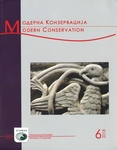 Modern Conservation No. 6. Šekaric, Branka (ed.). Belgrade, ICOMOS Serbia, 2018, 337 p., illus. [Ser, Eng] Modern Conservation No. 6. Šekaric, Branka (ed.). Belgrade, ICOMOS Serbia, 2018, 337 p., illus. [Ser, Eng]
ISSN 2334-9239
|



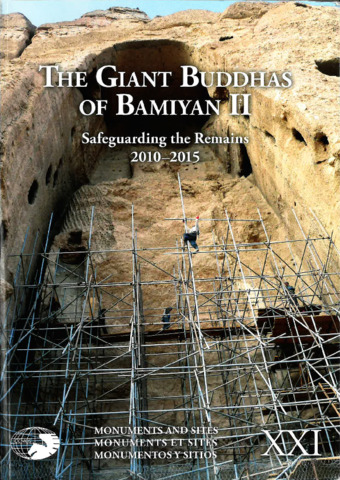 The giant Buddhas of Bamiyan II: safeguarding the remains 2010-2015. Edited by Erwin Emmeling and
The giant Buddhas of Bamiyan II: safeguarding the remains 2010-2015. Edited by Erwin Emmeling and 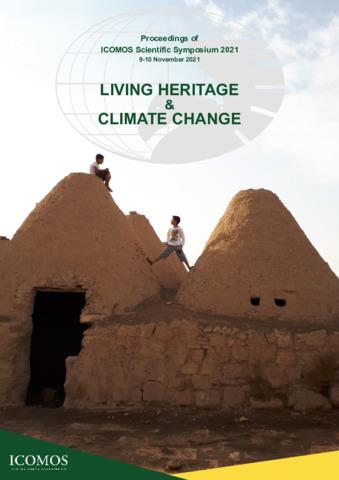 Living heritage and climate change: proceedings of ICOMOS scientific symposium 2021, 9-10 November 2021, online. Edited by Deirdre McDermott, Benthe Mathisen, Yasemin Sarıkaya Levent et al. ICOMOS, 2023. 205 p. ISBN 978-2-918086-75-8 [English, French, Spanish]
Living heritage and climate change: proceedings of ICOMOS scientific symposium 2021, 9-10 November 2021, online. Edited by Deirdre McDermott, Benthe Mathisen, Yasemin Sarıkaya Levent et al. ICOMOS, 2023. 205 p. ISBN 978-2-918086-75-8 [English, French, Spanish]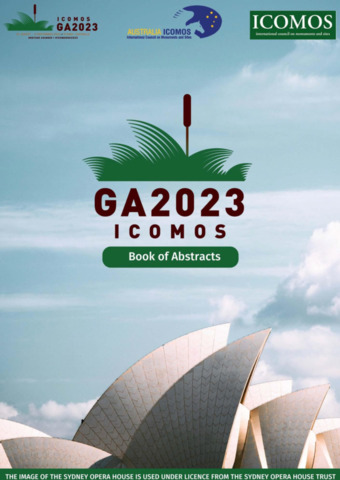 Heritage changes: ICOMOS 21st general assembly and scientific symposium. Sydney, Australia, 1-8 September 2023. Book of abstracts. Edited by Steve Brown and Ona Vileikis. ICOMOS, 2023. 477 p. ISBN 978-2-918086-90-1 [English, French, Spanish]
Heritage changes: ICOMOS 21st general assembly and scientific symposium. Sydney, Australia, 1-8 September 2023. Book of abstracts. Edited by Steve Brown and Ona Vileikis. ICOMOS, 2023. 477 p. ISBN 978-2-918086-90-1 [English, French, Spanish]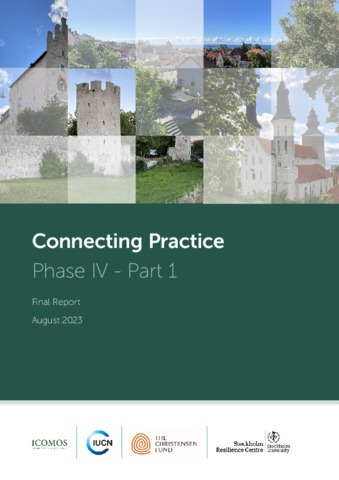 Leticia Leitão, Steve Brown. ICOMOS & IUCN, 2023. 53 p. ISBN 978-2-918086-96-3. [English] [French]
Leticia Leitão, Steve Brown. ICOMOS & IUCN, 2023. 53 p. ISBN 978-2-918086-96-3. [English] [French]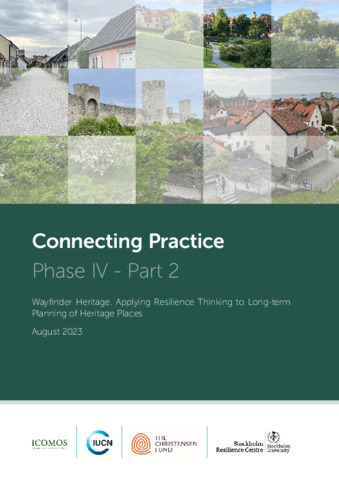
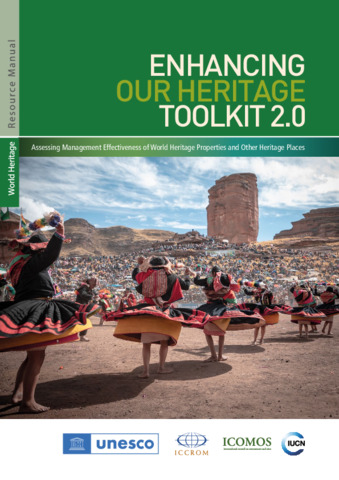 Enhancing our heritage toolkit 2.0: assessing management effectiveness of World Heritage properties and other heritage places. Edited by Laura Frank, Eugene Jo, Leticia Leitão, Carlo Ossola. UNESCO, ICCROM, ICOMOS & UICN, 2023. 132 p. ISBN 978-92-3-100623-4 [English]
Enhancing our heritage toolkit 2.0: assessing management effectiveness of World Heritage properties and other heritage places. Edited by Laura Frank, Eugene Jo, Leticia Leitão, Carlo Ossola. UNESCO, ICCROM, ICOMOS & UICN, 2023. 132 p. ISBN 978-92-3-100623-4 [English]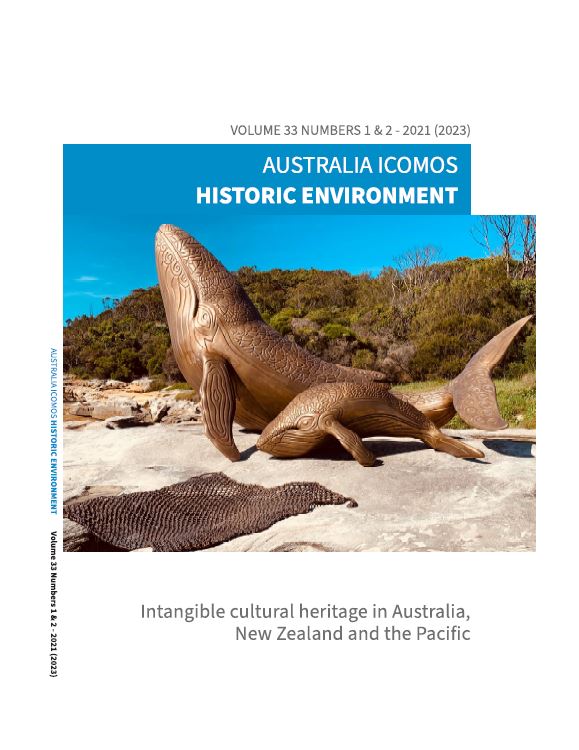 Intangible cultural heritage in Australia, New Zealand and the Pacific. Edited by Tracy Ireland, Amy Clarke, Rebecca Hawcroft et al. ICOMOS Australia, 2021-2023. 176 p. (Historic Environment, ISSN 0726-6715; vol. 33 n° 1 & 2). [English]
Intangible cultural heritage in Australia, New Zealand and the Pacific. Edited by Tracy Ireland, Amy Clarke, Rebecca Hawcroft et al. ICOMOS Australia, 2021-2023. 176 p. (Historic Environment, ISSN 0726-6715; vol. 33 n° 1 & 2). [English]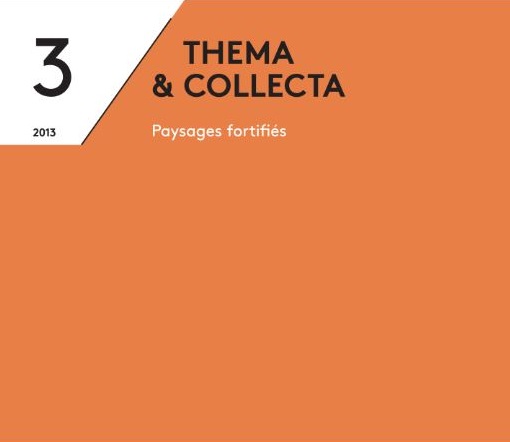 Paysages fortifiés. Edited by Stéphane Demeter. ICOMOS Wallonie-Bruxelles, 2014. 71 p. (Thema & Collecta, 3). ISBN 978-2-9600205-4-0 [French]
Paysages fortifiés. Edited by Stéphane Demeter. ICOMOS Wallonie-Bruxelles, 2014. 71 p. (Thema & Collecta, 3). ISBN 978-2-9600205-4-0 [French] Le patrimoine : un modèle de développement durable. Quelles performances énergétiques pour le patrimoine architectural et urbain en Europe et en Méditerranée ? = Heritage: a model for sustainable development. How to improve energy performance in European and Mediterranean architectural and urban heritage? Edited by Christophe Graz, Michèle Tilmont and Cédric Gottfried. ICOMOS France, 2011. 120 p. (Les Cahiers d'ICOMOS France, 26). [French, English]
Le patrimoine : un modèle de développement durable. Quelles performances énergétiques pour le patrimoine architectural et urbain en Europe et en Méditerranée ? = Heritage: a model for sustainable development. How to improve energy performance in European and Mediterranean architectural and urban heritage? Edited by Christophe Graz, Michèle Tilmont and Cédric Gottfried. ICOMOS France, 2011. 120 p. (Les Cahiers d'ICOMOS France, 26). [French, English]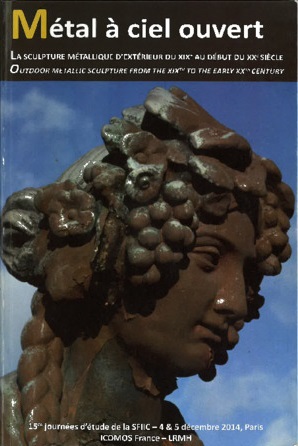 Métal à ciel ouvert : la sculpture métallique d'extérieur du XIXe au début du XXe siècle. Identification, conservation, restauration = Open air metal: outdoor metallic sculpture from the XIXth to the early XXth century. Identification, conservation, restoration. Aurélia Azéma (ed.), Annick Texier (ed.). Section française de l'institut international de conservation, 2014. 284 p. ISBN 978-2-905430-18-2 [French & English]
Métal à ciel ouvert : la sculpture métallique d'extérieur du XIXe au début du XXe siècle. Identification, conservation, restauration = Open air metal: outdoor metallic sculpture from the XIXth to the early XXth century. Identification, conservation, restoration. Aurélia Azéma (ed.), Annick Texier (ed.). Section française de l'institut international de conservation, 2014. 284 p. ISBN 978-2-905430-18-2 [French & English]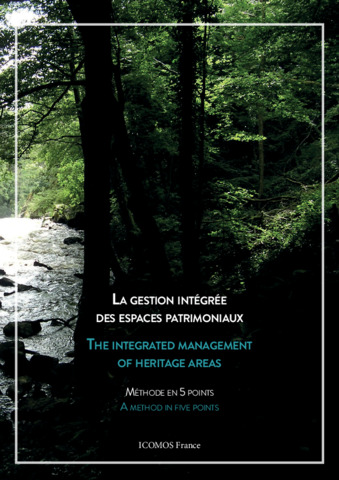 La gestion intégrée des espaces patrimoniaux : méthode en 5 points = The integrated management of heritage areas: a method in 5 points. Edited by Anne-Sophie Barré, Marc Gueyda, Isabelle Palmi et al. ICOMOS France, 2020. 18 p. (Les Cahiers d'ICOMOS France, 31). [French, English]
La gestion intégrée des espaces patrimoniaux : méthode en 5 points = The integrated management of heritage areas: a method in 5 points. Edited by Anne-Sophie Barré, Marc Gueyda, Isabelle Palmi et al. ICOMOS France, 2020. 18 p. (Les Cahiers d'ICOMOS France, 31). [French, English] Intervenir sur le bâti en bois : méthodes d'hier à aujourd'hui. Du diagnostic à son maintien dans le temps: Quel intervenant pour quelle intervention ? Edited by Anne-Sophie Barré. ICOMOS France & Section française de l'institut international de conservation, 2021. 265 p. (Les Cahiers d'ICOMOS France, 33) [French, English]
Intervenir sur le bâti en bois : méthodes d'hier à aujourd'hui. Du diagnostic à son maintien dans le temps: Quel intervenant pour quelle intervention ? Edited by Anne-Sophie Barré. ICOMOS France & Section française de l'institut international de conservation, 2021. 265 p. (Les Cahiers d'ICOMOS France, 33) [French, English]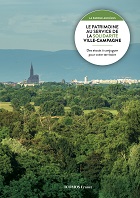 Edited by Anne-Catherine Gamerdinger, Marc Gayda, Chloé Mirouze et al. ICOMOS France, 2022. 153 p. (Les Cahiers d'ICOMOS France, ISSN 0297-3189; 34). [French]
Edited by Anne-Catherine Gamerdinger, Marc Gayda, Chloé Mirouze et al. ICOMOS France, 2022. 153 p. (Les Cahiers d'ICOMOS France, ISSN 0297-3189; 34). [French]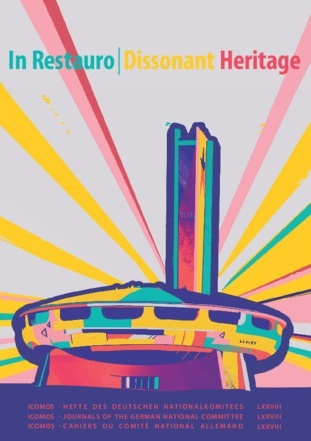 In restauro: post-war heritage of art and architecture in Central and Eastern Europe - integrated approaches to dissonant monuments and sites. Edited by Jörg Haspel, Jana Weydt, John Ziesemer. Hendrik Bäßler Verlag, 2023. 156 p. (ICOMOS Hefte des Deutschen Nationalkomitees, 78). ISBN 978-3-910447-09-7 [English]
In restauro: post-war heritage of art and architecture in Central and Eastern Europe - integrated approaches to dissonant monuments and sites. Edited by Jörg Haspel, Jana Weydt, John Ziesemer. Hendrik Bäßler Verlag, 2023. 156 p. (ICOMOS Hefte des Deutschen Nationalkomitees, 78). ISBN 978-3-910447-09-7 [English]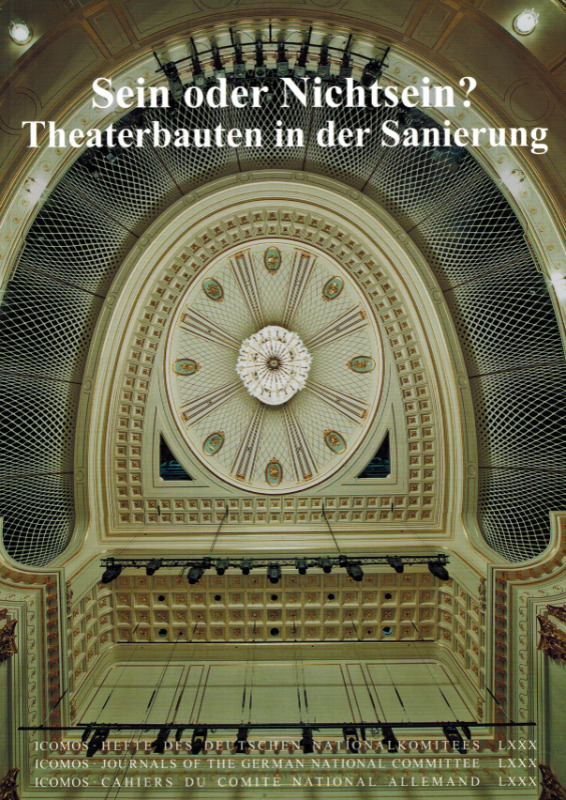 Sein oder Nichtsein? Theaterbauten in der Sanierung. Edited by Sigrid Brandt, Jörg Haspel and John Ziesemer. Hendrik Bäßler Verlag, 2023. 206 p. (ICOMOS Hefte des Deutschen Nationalkomitees, 80). ISBN 978-3-910447-09-7 [German]
Sein oder Nichtsein? Theaterbauten in der Sanierung. Edited by Sigrid Brandt, Jörg Haspel and John Ziesemer. Hendrik Bäßler Verlag, 2023. 206 p. (ICOMOS Hefte des Deutschen Nationalkomitees, 80). ISBN 978-3-910447-09-7 [German]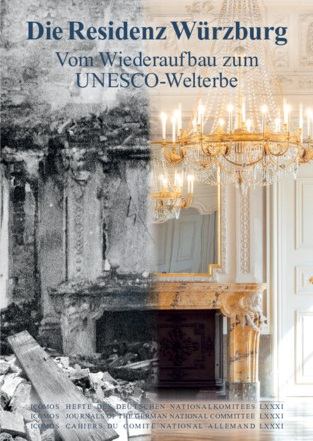 Die Residenz Würzburg: vom Wiederaufbau zum UNESCO-Welterbe - Rückblick und Herausforderung. Edited by Alexander Wiesneth and Ursula Schädler-Saub. Hendrik Bäßler Verlag, 2023. 175 p. (ICOMOS Hefte des Deutschen Nationalkomitees, 81). ISBN 978-3-910447-13-4 [German]
Die Residenz Würzburg: vom Wiederaufbau zum UNESCO-Welterbe - Rückblick und Herausforderung. Edited by Alexander Wiesneth and Ursula Schädler-Saub. Hendrik Bäßler Verlag, 2023. 175 p. (ICOMOS Hefte des Deutschen Nationalkomitees, 81). ISBN 978-3-910447-13-4 [German]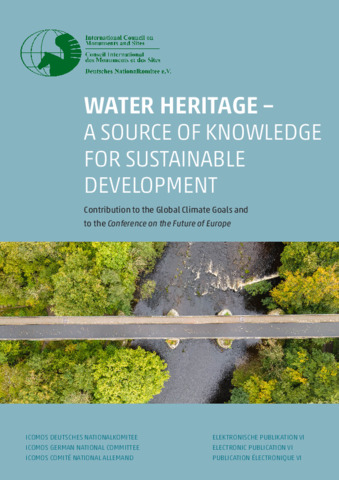 Water heritage - a source of knowledge for sustainable development: contribution to the global climate goals and to the Conference on the future of Europe. Edited by Jana Weydt and John Ziesemer. ICOMOS Germany, 2023. 59 p. ISBN 978-3-00-075921-5. [English]
Water heritage - a source of knowledge for sustainable development: contribution to the global climate goals and to the Conference on the future of Europe. Edited by Jana Weydt and John Ziesemer. ICOMOS Germany, 2023. 59 p. ISBN 978-3-00-075921-5. [English]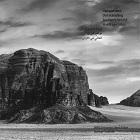 Unique and outstanding: Jordan's World Heritage sites. Dana Firas, Bashar Tabbas. ICOMOS Jordan, 2022. 249 p. ISBN 978-9923-9922-0-3 [English, Arabic]
Unique and outstanding: Jordan's World Heritage sites. Dana Firas, Bashar Tabbas. ICOMOS Jordan, 2022. 249 p. ISBN 978-9923-9922-0-3 [English, Arabic]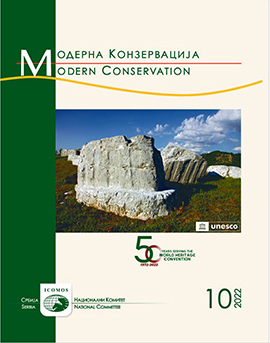 Модерна Конзервациjа 10 = Modern Conservation 10. Edited by Branka Šekarić and Sanja Kesić Ristić. ICOMOS Serbia, 2022. 307 p. ISBN 978-9923-9922-0-3 [English & Serbian]
Модерна Конзервациjа 10 = Modern Conservation 10. Edited by Branka Šekarić and Sanja Kesić Ristić. ICOMOS Serbia, 2022. 307 p. ISBN 978-9923-9922-0-3 [English & Serbian] Edited by Sonja Ifko and Jelka Pirkovič. ICOMOS Slovenia & Slovensko nacionalno združenje za spomenike in spomeniška območja, 2019. 147p. (Monographic Publication of Icomos Slovenia, 3). ISBN 978-961-94851-0-1 [English, Slovenian]
Edited by Sonja Ifko and Jelka Pirkovič. ICOMOS Slovenia & Slovensko nacionalno združenje za spomenike in spomeniška območja, 2019. 147p. (Monographic Publication of Icomos Slovenia, 3). ISBN 978-961-94851-0-1 [English, Slovenian]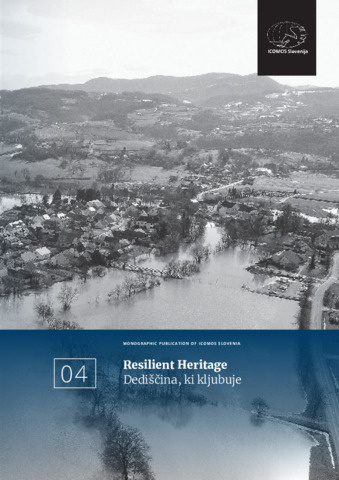 Edited by Sonja Ifko. ICOMOS Slovenia & Slovensko nacionalno združenje za spomenike in spomeniška območja, 2022. 190 p. (Monographic Publication of Icomos Slovenia, 4). ISBN 978-961-94851-4-9 [English, Slovenian]
Edited by Sonja Ifko. ICOMOS Slovenia & Slovensko nacionalno združenje za spomenike in spomeniška območja, 2022. 190 p. (Monographic Publication of Icomos Slovenia, 4). ISBN 978-961-94851-4-9 [English, Slovenian]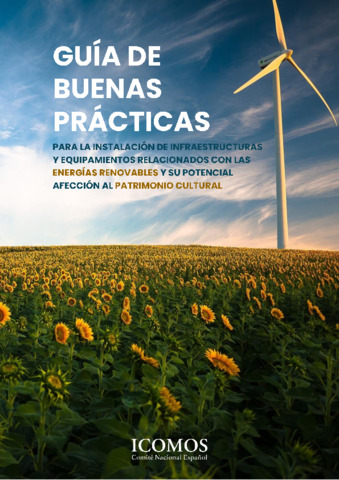 Guía de buenas prácticas para la instalación de infraestructuras y equipamientos relacionados con las energías renovables y su potencial afección al patrimonio cultural = Guidelines for the installation of renewable energy-related infrastructures and equipment and their potential impact on cultural heritage. José Alberto Alonso Campanero, Clara Villalba Montaner and Camino Enríquez Traba. ICOMOS Spain, 2023. 85 p. [Spanish] [English]
Guía de buenas prácticas para la instalación de infraestructuras y equipamientos relacionados con las energías renovables y su potencial afección al patrimonio cultural = Guidelines for the installation of renewable energy-related infrastructures and equipment and their potential impact on cultural heritage. José Alberto Alonso Campanero, Clara Villalba Montaner and Camino Enríquez Traba. ICOMOS Spain, 2023. 85 p. [Spanish] [English] Our Common Dignity - Rights-Based Approaches Working Group: history and milestones. Edited by Paulette Wallace, Bénédicte Selfslagh, Margaret Gowen et al. ICOMOS, 2023. 132 p. ISBN 978-2-918086-94-9. [English]
Our Common Dignity - Rights-Based Approaches Working Group: history and milestones. Edited by Paulette Wallace, Bénédicte Selfslagh, Margaret Gowen et al. ICOMOS, 2023. 132 p. ISBN 978-2-918086-94-9. [English]  Managing disaster risks to cultural heritage: from risk preparedness to recovery for immovable heritage. Edited by Bijan Rouhani and Xavier Romão. Routledge, 2023. 291 p. ISBN 978-1-03-220453-6 (paperback). [English]
Managing disaster risks to cultural heritage: from risk preparedness to recovery for immovable heritage. Edited by Bijan Rouhani and Xavier Romão. Routledge, 2023. 291 p. ISBN 978-1-03-220453-6 (paperback). [English]  The cultural heritages of water in tropical and subtropical Eastern and South-Eastern Asia. Thematic study. Compilation of articles.
The cultural heritages of water in tropical and subtropical Eastern and South-Eastern Asia. Thematic study. Compilation of articles.  Heritage and the sustainable development goals: policy guidance for heritage and development actors. Sophia Labadi, Francesca Giliberto, Ilaria Rosetti, Linda Shetabi, Ege Yildirim. ICOMOS, 2021 [English] & 2022 [French]. 134 p. illus. (PDF)
Heritage and the sustainable development goals: policy guidance for heritage and development actors. Sophia Labadi, Francesca Giliberto, Ilaria Rosetti, Linda Shetabi, Ege Yildirim. ICOMOS, 2021 [English] & 2022 [French]. 134 p. illus. (PDF) Global research and action agenda on culture, heritage and climate change. Hana Morel, William Megarry, Andrew Potts et al. ICOMOS & ISCM CHC, 2022. 75 p. ISBN 978-2-918086-69-7 (PDF) [English] - 978-2-918086-70-3 (print) [English] - 978-2-918086-79-6 (PDF) [French]
Global research and action agenda on culture, heritage and climate change. Hana Morel, William Megarry, Andrew Potts et al. ICOMOS & ISCM CHC, 2022. 75 p. ISBN 978-2-918086-69-7 (PDF) [English] - 978-2-918086-70-3 (print) [English] - 978-2-918086-79-6 (PDF) [French] ICSM CHC White Paper I: Intangible cultural heritage, diverse knowledge systems and climate change. Contribution of Knowledge Systems Group I to the International Co-Sponsored Meeting on Culture, Heritage and Climate Change. Ben Orlove, Neil Dawson, Pasang Sherpa et al. ICOMOS & ISCM CHC, 2022. 103 p. ISBN 978-2-918086-71-0 (PDF) [English]
ICSM CHC White Paper I: Intangible cultural heritage, diverse knowledge systems and climate change. Contribution of Knowledge Systems Group I to the International Co-Sponsored Meeting on Culture, Heritage and Climate Change. Ben Orlove, Neil Dawson, Pasang Sherpa et al. ICOMOS & ISCM CHC, 2022. 103 p. ISBN 978-2-918086-71-0 (PDF) [English] ICSM CHC White Paper II: Impacts, vulnerability, and understanding risks of climate change for culture and heritage: Contribution of Impacts Group II to the International Co-Sponsored Meeting on Culture, Heritage and Climate Change. Nicholas P. Simpson, Scott Allan Orr, Salma Sabour et al. ICOMOS & ISCM CHC, 2022.109 p. ISBN 978-2-918086-72-7 (PDF) [English]
ICSM CHC White Paper II: Impacts, vulnerability, and understanding risks of climate change for culture and heritage: Contribution of Impacts Group II to the International Co-Sponsored Meeting on Culture, Heritage and Climate Change. Nicholas P. Simpson, Scott Allan Orr, Salma Sabour et al. ICOMOS & ISCM CHC, 2022.109 p. ISBN 978-2-918086-72-7 (PDF) [English] ICSM CHC White Paper III: The role of cultural and natural heritage for climate action: Contribution of Impacts Group III to the International Co-Sponsored Meeting on Culture, Heritage and Climate Change. Nick Shepherd, Joshua Benjamin Cohen, William Carmen et al. ICOMOS & ISCM CHC, 2022. 91 p. ISBN 978-2-918086-73-4 (PDF) [English]
ICSM CHC White Paper III: The role of cultural and natural heritage for climate action: Contribution of Impacts Group III to the International Co-Sponsored Meeting on Culture, Heritage and Climate Change. Nick Shepherd, Joshua Benjamin Cohen, William Carmen et al. ICOMOS & ISCM CHC, 2022. 91 p. ISBN 978-2-918086-73-4 (PDF) [English] An application of the Climate Vulnerability Index for the Sukur Cultural Landscape. Jon C. Day, Scott F. Heron, Ishanlosen Odiaua et al. ICOMOS Nigeria, 2022. 60 p. ISBN 978-2-918086-83-3 (PDF) [English]
An application of the Climate Vulnerability Index for the Sukur Cultural Landscape. Jon C. Day, Scott F. Heron, Ishanlosen Odiaua et al. ICOMOS Nigeria, 2022. 60 p. ISBN 978-2-918086-83-3 (PDF) [English] Application of the Climate Vulnerability Index for the Ruins of Kilwa Kisiwani and the Ruins of Songo Mnara, Tanzania. Scott F. Heron, Jon D. Day, Mercy Mbogelah et al. CVI Africa Project, 2022. 52 p. ISBN 978-2-918086-84-0 (PDF) [English] - 978-2-918086-85-7 (PDF) [Swahili]
Application of the Climate Vulnerability Index for the Ruins of Kilwa Kisiwani and the Ruins of Songo Mnara, Tanzania. Scott F. Heron, Jon D. Day, Mercy Mbogelah et al. CVI Africa Project, 2022. 52 p. ISBN 978-2-918086-84-0 (PDF) [English] - 978-2-918086-85-7 (PDF) [Swahili] Guidance and toolkit for impact assessments in a World Heritage context. Sarah Court, Eugene Jo, Richard Mackay et al. UNESCO, ICCROM, ICOMOS et UICN, 2022. 87 p. ISBN 978-92-3-100535-0 (PDF) [English]
Guidance and toolkit for impact assessments in a World Heritage context. Sarah Court, Eugene Jo, Richard Mackay et al. UNESCO, ICCROM, ICOMOS et UICN, 2022. 87 p. ISBN 978-92-3-100535-0 (PDF) [English] Heritage Under Water at Risk: Threats, Challenges and Solutions. Albert Hafner (ed.), Hakan Öniz (ed.), Lucy Semaan (ed.), Christopher Underwood (ed.). ICOMOS, 2022. 215 p. (Heritage at Risk, special edition.) ISBN 978-2-918086-37-6 (print), 978-2-918086-38-3 (PDF). [English]
Heritage Under Water at Risk: Threats, Challenges and Solutions. Albert Hafner (ed.), Hakan Öniz (ed.), Lucy Semaan (ed.), Christopher Underwood (ed.). ICOMOS, 2022. 215 p. (Heritage at Risk, special edition.) ISBN 978-2-918086-37-6 (print), 978-2-918086-38-3 (PDF). [English] Regenerating cultural religious heritage: intercultural dialogue on places of religion and rituals. Olimpia Niglio, Andrea Longhi, Henrik Lindblad et al. Springer, 2022. 300 p. ISBN 978-981-19-3469-8 (print), 978-981-19-3470-4 (PDF) [English]
Regenerating cultural religious heritage: intercultural dialogue on places of religion and rituals. Olimpia Niglio, Andrea Longhi, Henrik Lindblad et al. Springer, 2022. 300 p. ISBN 978-981-19-3469-8 (print), 978-981-19-3470-4 (PDF) [English] Religious heritage: Celebrating and conserving places of religious and ritual significance in a global world and changing climates. ICOMOS scientific symposium 2022 book of abstracts. 29-30 October 2022, Fine Arts department, Bangkok, Thailand. ICOMOS, 2022. 135 p. [English & French]
Religious heritage: Celebrating and conserving places of religious and ritual significance in a global world and changing climates. ICOMOS scientific symposium 2022 book of abstracts. 29-30 October 2022, Fine Arts department, Bangkok, Thailand. ICOMOS, 2022. 135 p. [English & French]
 The look of leisure: Historic seaside villas of the Northern Baltic. Laura Berger (éd.). Helsinki: ICOMOS Finland & Finnish Architecture Society, 2021. 205 p. ISBN 978-952-68812-6-3 (print). [English]
The look of leisure: Historic seaside villas of the Northern Baltic. Laura Berger (éd.). Helsinki: ICOMOS Finland & Finnish Architecture Society, 2021. 205 p. ISBN 978-952-68812-6-3 (print). [English] Seminario Internacional "Intervención y legislación en centros históricos". 22-26 February 2021, Panamá. Actas. Silvia Arroyo Duarte, Antonio Cubero Hernández, María Teresa Pérez Cano et al. ICOMOS Panama, 2022. 107 p. ISBN 978-0-9568370-1-1 (PDF) [Spanish]
Seminario Internacional "Intervención y legislación en centros históricos". 22-26 February 2021, Panamá. Actas. Silvia Arroyo Duarte, Antonio Cubero Hernández, María Teresa Pérez Cano et al. ICOMOS Panama, 2022. 107 p. ISBN 978-0-9568370-1-1 (PDF) [Spanish] Integration of climate action and the sustainable development goals in World Heritage sites: Case – Taj Mahal and the University of Virginia and Monticello. Shinjini Saha, Caballero, Gabriel Victor, Lydia Loopesko. ICOMOS SDG WG, 2022. 83 p. (PDF) [English]
Integration of climate action and the sustainable development goals in World Heritage sites: Case – Taj Mahal and the University of Virginia and Monticello. Shinjini Saha, Caballero, Gabriel Victor, Lydia Loopesko. ICOMOS SDG WG, 2022. 83 p. (PDF) [English]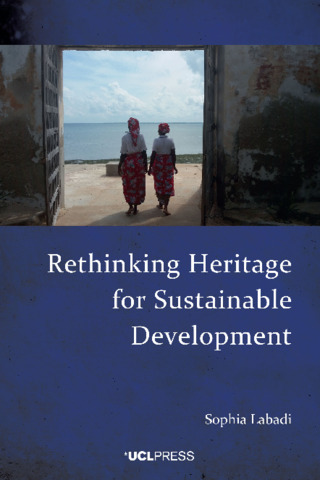 Rethinking heritage for sustainable development. Sophia Labadi. London, UK: UCL Press, 2022. 244 p. ISBN 978-1-80008-194-9 (hardback), 978-1-80008-193-2 (paperback), 978-1-80008- 192-5 (PDF), 978-1-80008-195-6 (epub). [English]
Rethinking heritage for sustainable development. Sophia Labadi. London, UK: UCL Press, 2022. 244 p. ISBN 978-1-80008-194-9 (hardback), 978-1-80008-193-2 (paperback), 978-1-80008- 192-5 (PDF), 978-1-80008-195-6 (epub). [English] 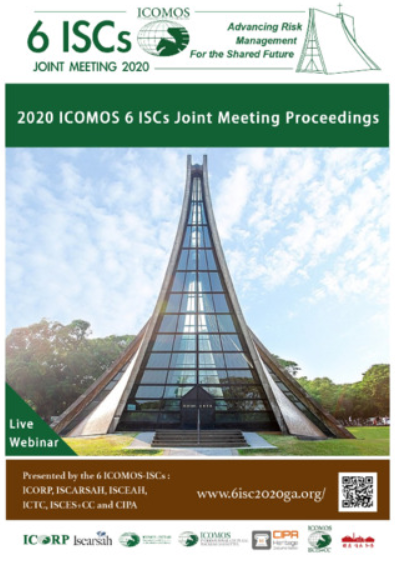 2020 ICOMOS 6 ISCs Joint Meeting Proceedings: Advancing Risk Management for the Shared Future. Conference Volume. Bureau of Cultural Heritage, Ministry of Culture, Taiwan, R.O.C, Taiwan, 332 p. [Eng]
2020 ICOMOS 6 ISCs Joint Meeting Proceedings: Advancing Risk Management for the Shared Future. Conference Volume. Bureau of Cultural Heritage, Ministry of Culture, Taiwan, R.O.C, Taiwan, 332 p. [Eng]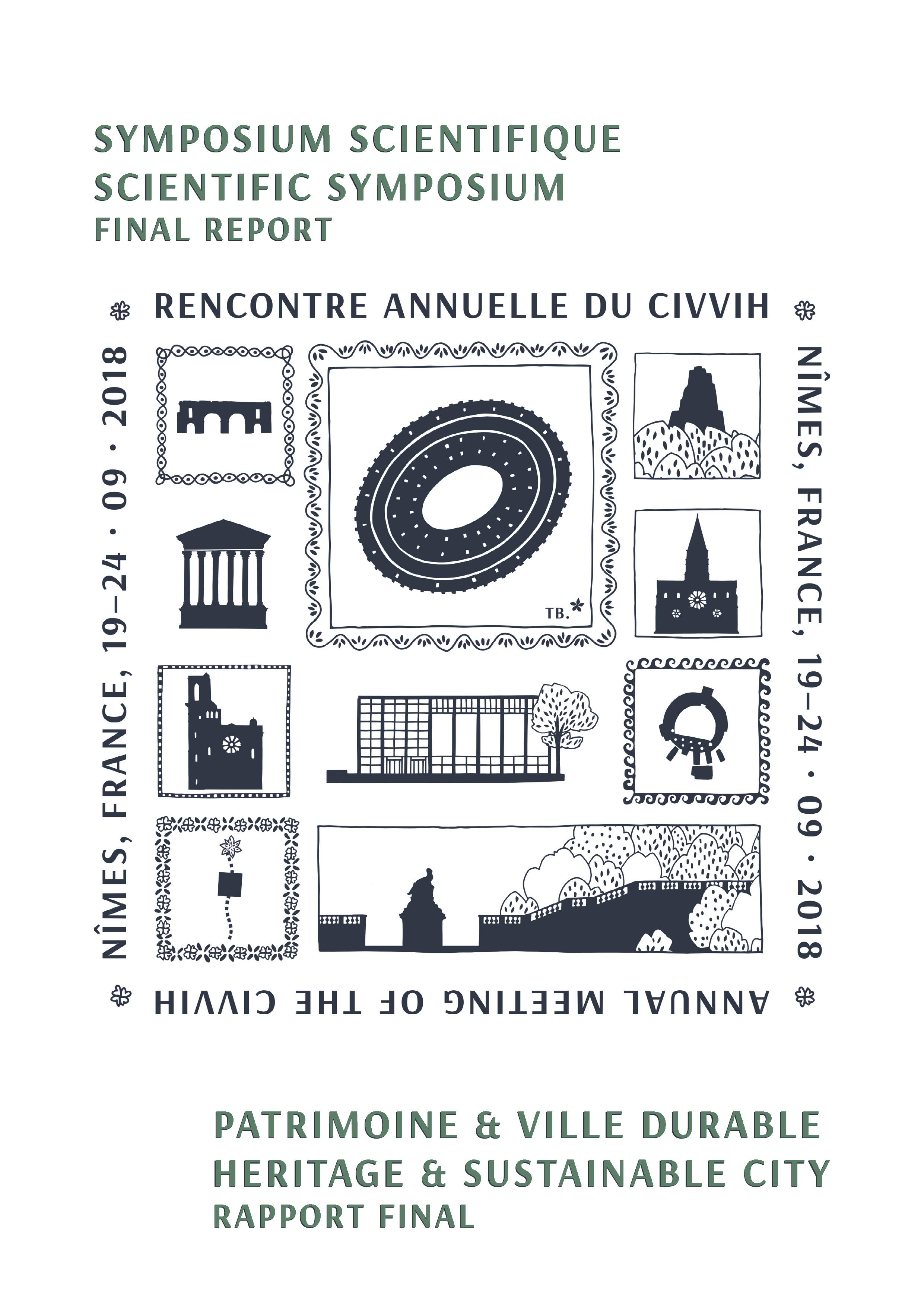


 Current research in heritage and conservation studies from Australia and New Zealand. eritage, sustainability and social justice. Volume 31, No. 1. Ireland, Tracy (ed.) Victoria, Australia Icomos, 2020. 116 p. [Eng]
Current research in heritage and conservation studies from Australia and New Zealand. eritage, sustainability and social justice. Volume 31, No. 1. Ireland, Tracy (ed.) Victoria, Australia Icomos, 2020. 116 p. [Eng]


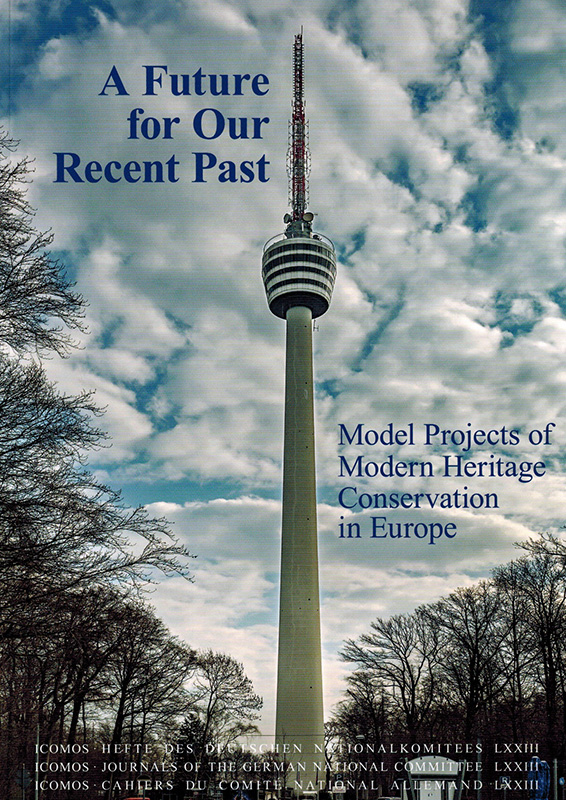
 Tech im 19. Jahrhundert. Ziesemer, John (ed.). Berlin: Hendrik Bäβler Verlag, 2019 (ICOMOS - Hefte des Deutschen Nationalkomitees LXX). [Eng & Ger]
Tech im 19. Jahrhundert. Ziesemer, John (ed.). Berlin: Hendrik Bäβler Verlag, 2019 (ICOMOS - Hefte des Deutschen Nationalkomitees LXX). [Eng & Ger] 100 Godina Bahausa. Turkušić Jurić, Elša (ed.). Sarajevo, National Committee of ICOMOS in Bosnia and Herzegovina, 2020. 104 p. [Bos]
100 Godina Bahausa. Turkušić Jurić, Elša (ed.). Sarajevo, National Committee of ICOMOS in Bosnia and Herzegovina, 2020. 104 p. [Bos]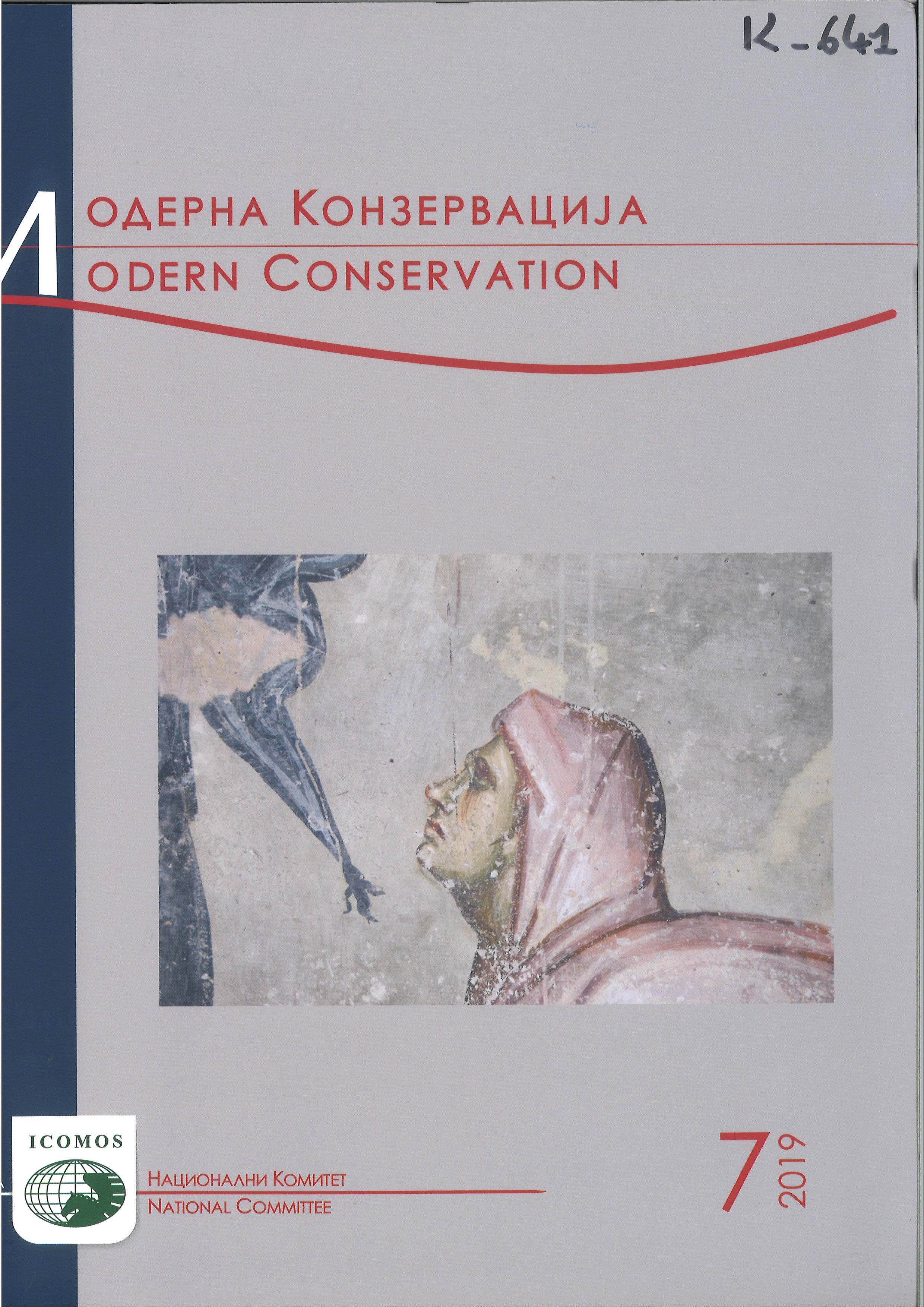 Modern Conservation No.7. Šekaric, Branka (ed.). Belgrade, ICOMOS Serbie, 2019, 241 p.illus. [Ser, summaries in Eng]
Modern Conservation No.7. Šekaric, Branka (ed.). Belgrade, ICOMOS Serbie, 2019, 241 p.illus. [Ser, summaries in Eng]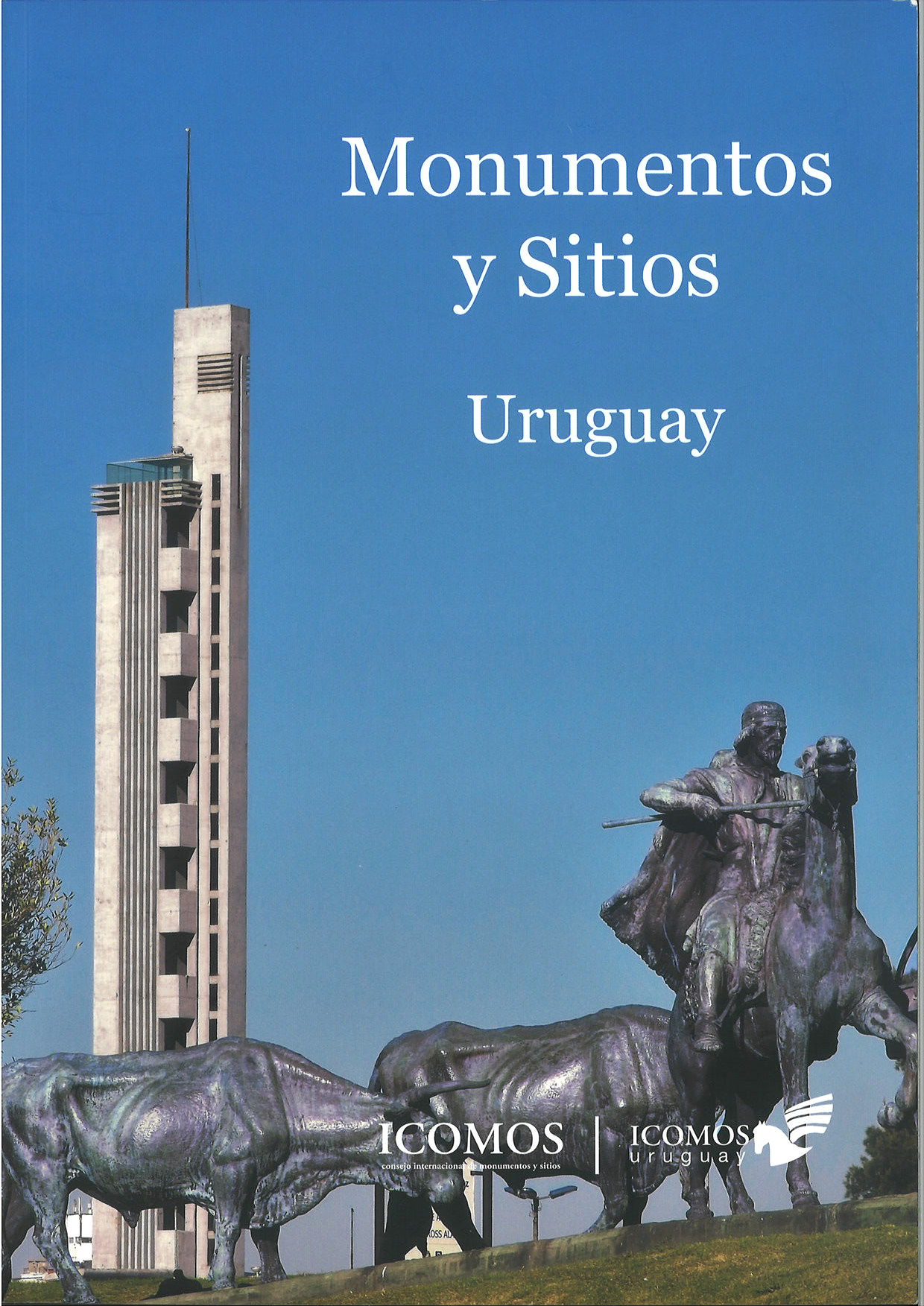 Monumentos y Sitios: Uruguay. Béhèran, Ricardo (ed.), Mazzini, Elena (ed.). Montevideo, ICOMOS Uruguay, 2019. 208 p., illus. [Spa, résumés en Eng]
Monumentos y Sitios: Uruguay. Béhèran, Ricardo (ed.), Mazzini, Elena (ed.). Montevideo, ICOMOS Uruguay, 2019. 208 p., illus. [Spa, résumés en Eng] La gestion du risque en Belgique. Patricio,Teresa (ed.). Bruxelles : ICOMOS Wallonie-Bruxelle asbl, 2020. (Thema & Collecta, 7/2020). 151 p., illus. [Fre]
La gestion du risque en Belgique. Patricio,Teresa (ed.). Bruxelles : ICOMOS Wallonie-Bruxelle asbl, 2020. (Thema & Collecta, 7/2020). 151 p., illus. [Fre]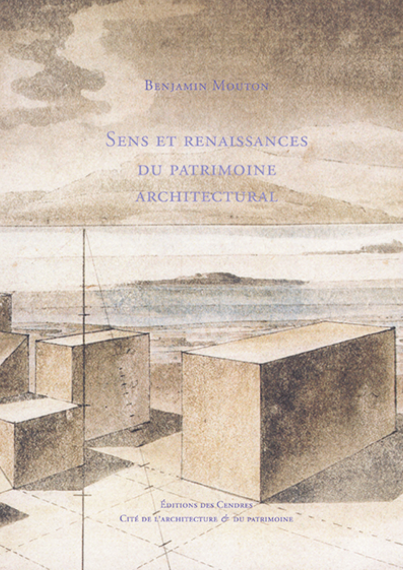 Sens et renaissances du patrimoine architectural. Mouton, Benjamin. Paris : Cité de l’architecture & du patrimoine / Éditions des Cendres, 2018. 416 p., ill. [Fre]
Sens et renaissances du patrimoine architectural. Mouton, Benjamin. Paris : Cité de l’architecture & du patrimoine / Éditions des Cendres, 2018. 416 p., ill. [Fre]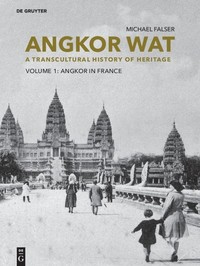 ISBN 978-3-11-033572-9
ISBN 978-3-11-033572-9 Volume I (Angkor in France) reconceptualizes the Orientalist, French-colonial 'discovery' of the temple in the nineteenth century and brings to light the manifold strategies at play in its physical representations as plaster cast substitutes in museums and as hybrid pavilions in universal and colonial exhibitions in Marseille and Paris from 1867 to 1937.
Volume I (Angkor in France) reconceptualizes the Orientalist, French-colonial 'discovery' of the temple in the nineteenth century and brings to light the manifold strategies at play in its physical representations as plaster cast substitutes in museums and as hybrid pavilions in universal and colonial exhibitions in Marseille and Paris from 1867 to 1937.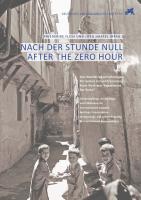 Denkmalpflege, Archäologie und Städtebau als internationale Aufgabe /
Denkmalpflege, Archäologie und Städtebau als internationale Aufgabe / 

 Kernkraftwerke : DenKmalwerte und Erhaltungschancen / Nuclear Power Stations: Heritage Values and Preservation Perspectives. Brandt, SIgrid et Thorsten, Dame (ed.). Berlin, Hendrik Bäβler Verlag, 2019. 128 p., illus. (ICOMOS Hefte des Deutschen Nationalkomitees, LXVIII) [Ger and Eng]
Kernkraftwerke : DenKmalwerte und Erhaltungschancen / Nuclear Power Stations: Heritage Values and Preservation Perspectives. Brandt, SIgrid et Thorsten, Dame (ed.). Berlin, Hendrik Bäβler Verlag, 2019. 128 p., illus. (ICOMOS Hefte des Deutschen Nationalkomitees, LXVIII) [Ger and Eng]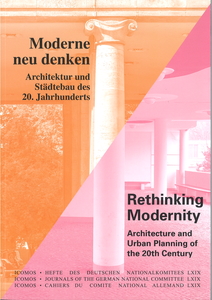 Modern neu denken: Architektur und Städtebau des 20. Jahrhunderts, zwischen Avantgarde und Tradition / Rethinking Modernity: Architecture and Urban planning of the 20th Century, between Avant-Garde and Tradition. Ziesemer, John (ed.). Berlin, Karl Krämer Verlag Stuttgart, 2019. 192 p., illus. (ICOMOS Hefte des Deutschen Nationalkomitees, LXIX) [Ger andEng]
Modern neu denken: Architektur und Städtebau des 20. Jahrhunderts, zwischen Avantgarde und Tradition / Rethinking Modernity: Architecture and Urban planning of the 20th Century, between Avant-Garde and Tradition. Ziesemer, John (ed.). Berlin, Karl Krämer Verlag Stuttgart, 2019. 192 p., illus. (ICOMOS Hefte des Deutschen Nationalkomitees, LXIX) [Ger andEng]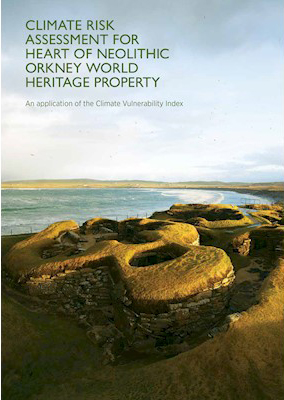 Climate risk assessment for heart of neolithic Orkney World Heritage property. Day JC, Heron SF, Markham A, Downes J, Gibson J, Hyslop E, Jones RH, Lyall A. Edinburgh, Historic Environment Scotland, 2019. 88 p. [Eng]
Climate risk assessment for heart of neolithic Orkney World Heritage property. Day JC, Heron SF, Markham A, Downes J, Gibson J, Hyslop E, Jones RH, Lyall A. Edinburgh, Historic Environment Scotland, 2019. 88 p. [Eng]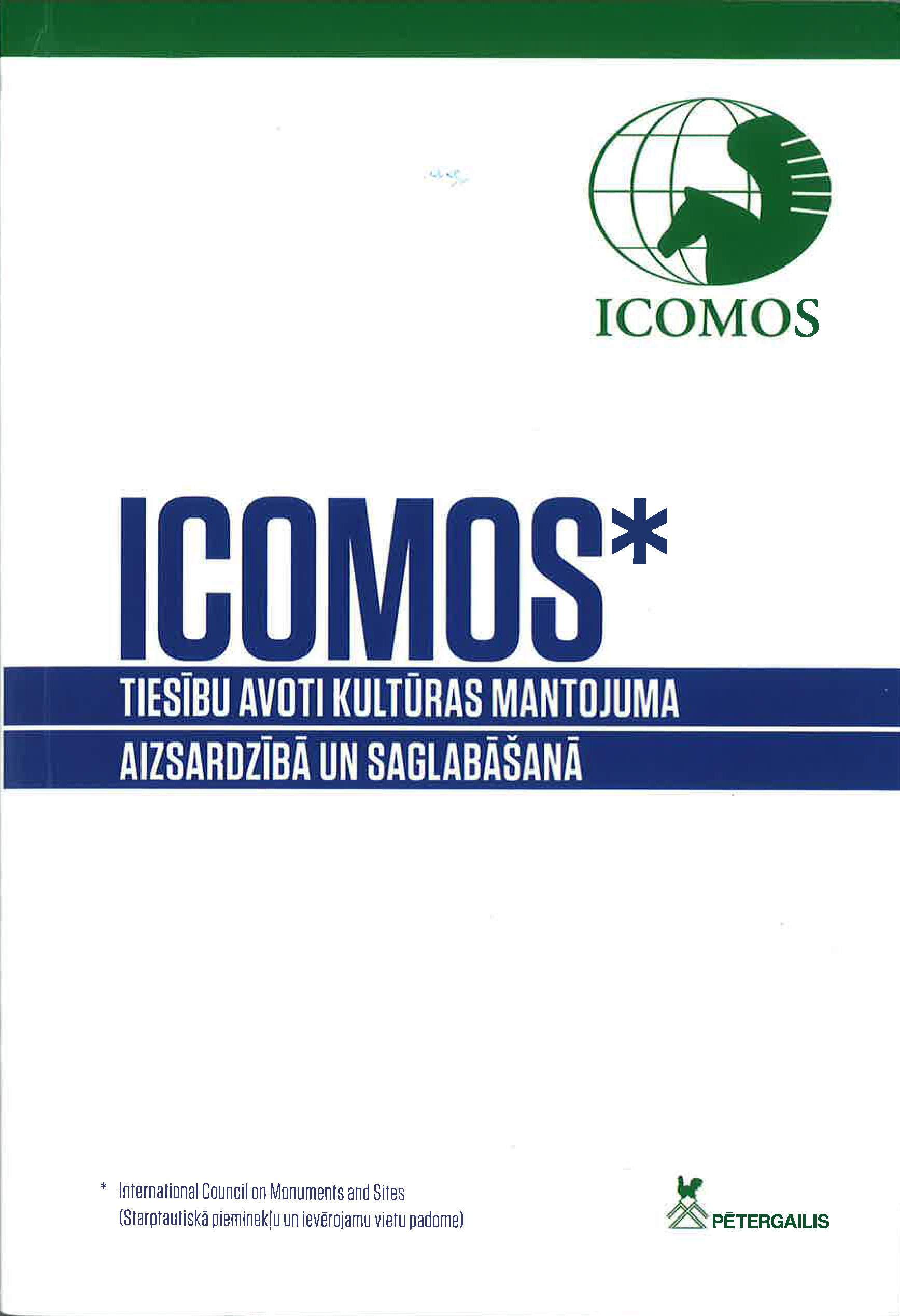 ICOMOS tiesību avoti kultūras mantojuma aizsardzībā. Lejnieks, Janis (ed.). Riga, ICOMOS Latvia / "Petergailis" publishing house, 2018. 167 p. [Lav]
ICOMOS tiesību avoti kultūras mantojuma aizsardzībā. Lejnieks, Janis (ed.). Riga, ICOMOS Latvia / "Petergailis" publishing house, 2018. 167 p. [Lav] Retour à l'esprit de la Charte de Venise / Back to ths spirit of the Venice charter. Summary and conclusions of the seminar organized by ICOMOS France. Mouton, Benjamin (ed.), Schneider, Dominique (ed.). Paris, ICOMOS France, 2019. 43 p. [Fre & Eng]
Retour à l'esprit de la Charte de Venise / Back to ths spirit of the Venice charter. Summary and conclusions of the seminar organized by ICOMOS France. Mouton, Benjamin (ed.), Schneider, Dominique (ed.). Paris, ICOMOS France, 2019. 43 p. [Fre & Eng] Management of cultural heritage sites / Upravljanje kulturne dediscine. Book of abstracts / Kniga povzetkov. 3rd International Symposium on Cultural Heritage and Legal Issues, Bled, 20-22 September 2018. Ifko, Sonja (ed.). Ljubljana, ICOMOS Slovenija, 2018. 51 p. [Slo & Eng]
Management of cultural heritage sites / Upravljanje kulturne dediscine. Book of abstracts / Kniga povzetkov. 3rd International Symposium on Cultural Heritage and Legal Issues, Bled, 20-22 September 2018. Ifko, Sonja (ed.). Ljubljana, ICOMOS Slovenija, 2018. 51 p. [Slo & Eng]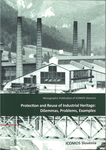 Protection and Reuse of Industrial Heritage: Dilemmas, Problems, Examples. Ifko, Sonja (ed.), Stokin, Mario (ed.). Ljubljana, ICOMOS Slovenija, 2018. 147 p. (Monographic publications of ICOMOS Slovenia, 2). [Eng]
Protection and Reuse of Industrial Heritage: Dilemmas, Problems, Examples. Ifko, Sonja (ed.), Stokin, Mario (ed.). Ljubljana, ICOMOS Slovenija, 2018. 147 p. (Monographic publications of ICOMOS Slovenia, 2). [Eng]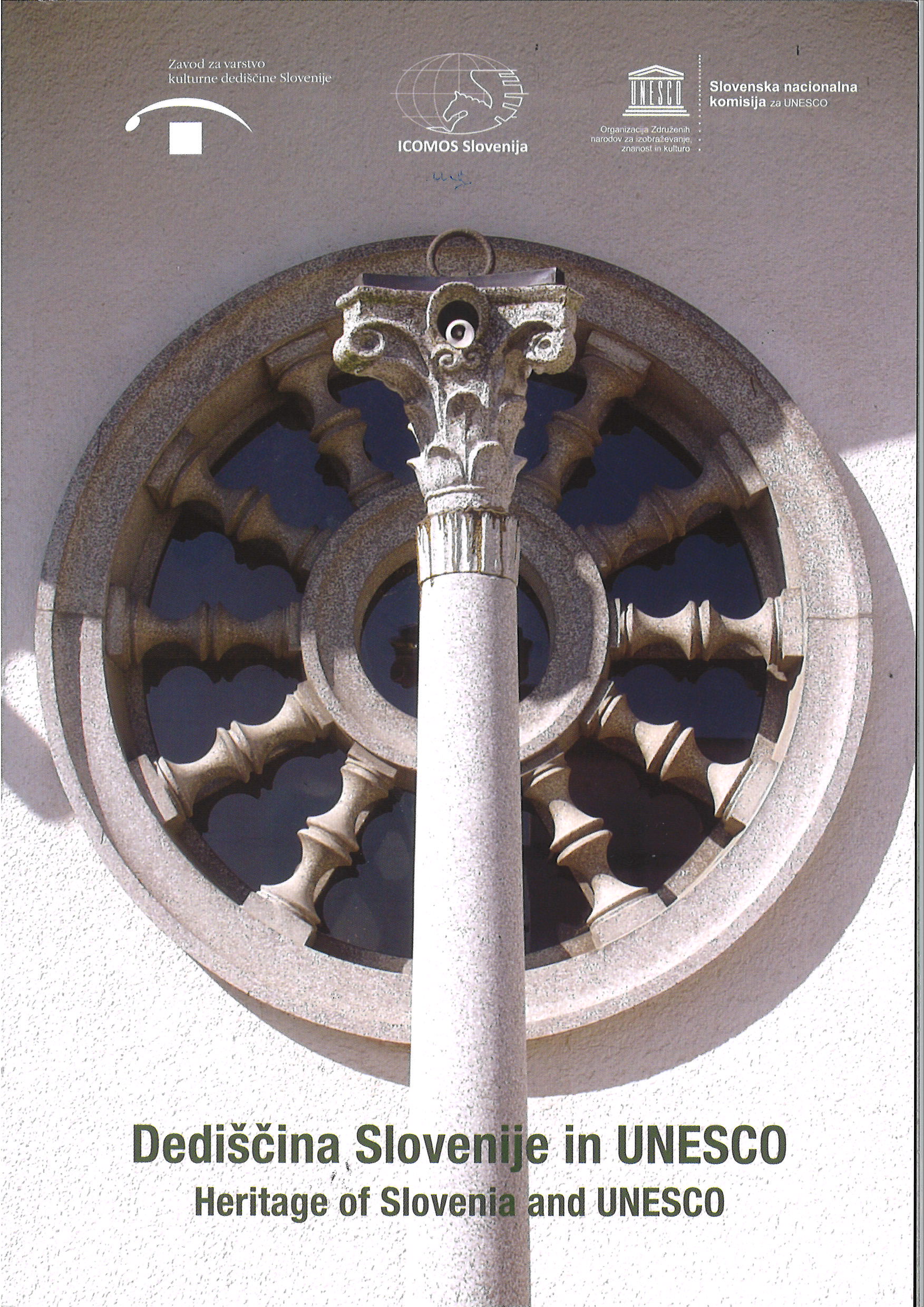 Dediščina Slovenije in UNESCO / Heritage of Slovenia and UNESCO. Ribnikar Vasle, Biserka (ed.). Ljubljana, ICOMOS Slovenia (in cooperation with the Office of the Slovenian National Commission for UNESCO), 2016. 83 p. [Slo & Eng]
Dediščina Slovenije in UNESCO / Heritage of Slovenia and UNESCO. Ribnikar Vasle, Biserka (ed.). Ljubljana, ICOMOS Slovenia (in cooperation with the Office of the Slovenian National Commission for UNESCO), 2016. 83 p. [Slo & Eng] ICOMOS Korea / ISCARSAH
ICOMOS Korea / ISCARSAH